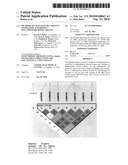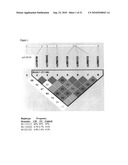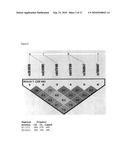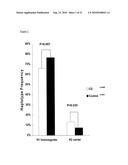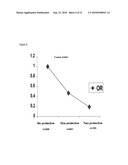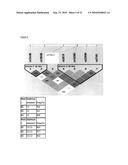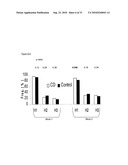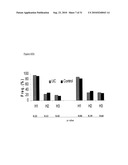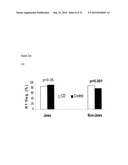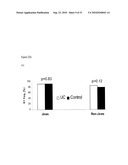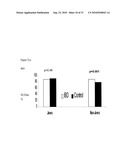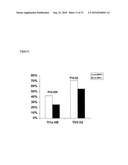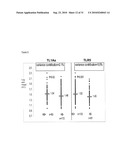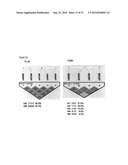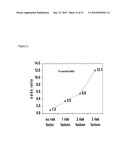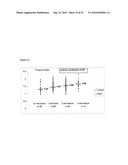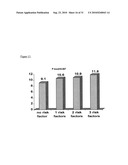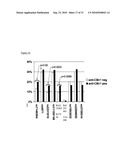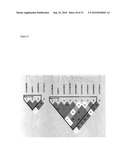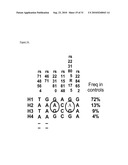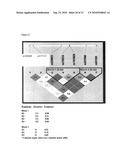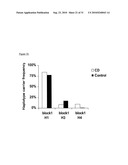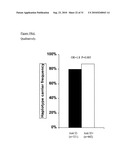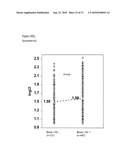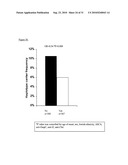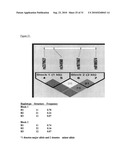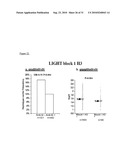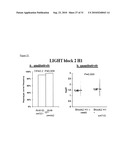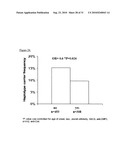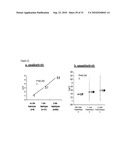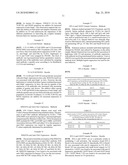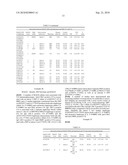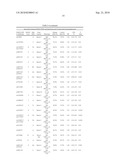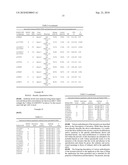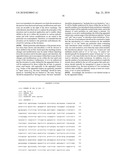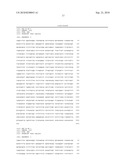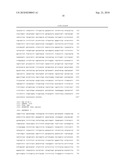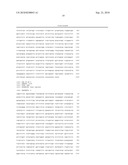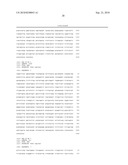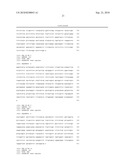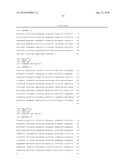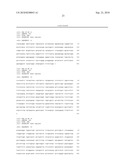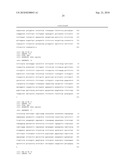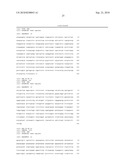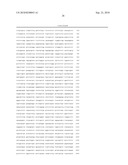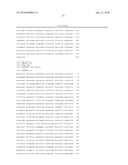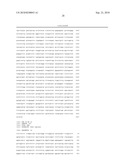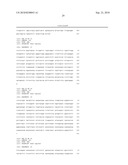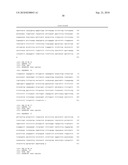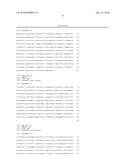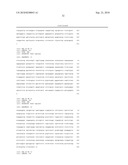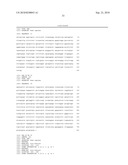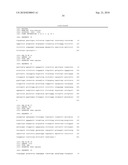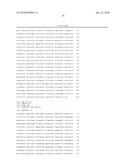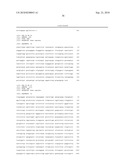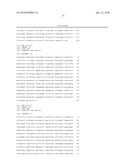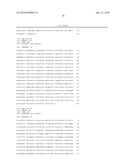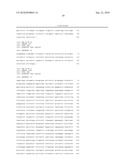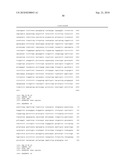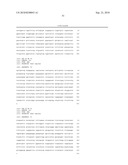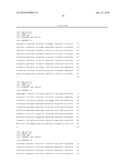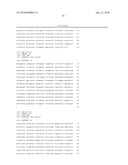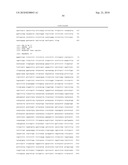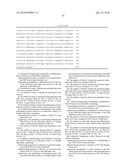Patent application title: METHODS OF USING GENETIC VARIANTS TO DIAGNOSE AND PREDICT INFLAMMATORY BOWEL DISEASE
Inventors:
Jerome I. Rotter (Los Angeles, CA, US)
Kent D. Taylor (Ventura, CA, US)
Stephan R. Targan (Santa Monica, CA, US)
Dermot P. Mcgovern (Los Angeles, CA, US)
Dermot P. Mcgovern (Los Angeles, CA, US)
Ling Mei (Pasadena, CA, US)
Xiaowen Su (Beverly Hills, CA, US)
Assignees:
CEDARS-SINAI MEDICAL CENTER
IPC8 Class: AC12Q168FI
USPC Class:
435 6
Class name: Chemistry: molecular biology and microbiology measuring or testing process involving enzymes or micro-organisms; composition or test strip therefore; processes of forming such composition or test strip involving nucleic acid
Publication date: 2010-09-23
Patent application number: 20100240043
Claims:
1. A method for diagnosing susceptibility to Inflammatory Bowel Disease in
an individual, comprising:determining the presence or absence of a risk
haplotype at the DR3 locus in the individual; anddiagnosing
susceptibility to Inflammatory Bowel Disease in the individual based upon
the presence of the risk haplotype at the DR3 locus.
2. The method of claim 1, wherein the risk haplotype at the DR3 locus comprises DR3 H2.
3. The method of claim 1, wherein the individual is non-Jewish.
4. The method of claim 1, wherein the risk haplotype at the DR3 locus comprises SEQ. ID. NO.: 7, SEQ. ID. NO.: 8, SEQ. ID. NO.: 9, SEQ. ID. NO.: 10, SEQ. ID. NO.: 11, SEQ. ID. NO.: 12 and/or SEQ. ID. NO.: 13.
5. The method of claim 1, wherein the Inflammatory Bowel Disease comprises Crohn's Disease and/or ulcerative colitis.
6. A method of determining a low probability of developing inflammatory Bowel Disease in an individual, relative to a healthy individual, comprising:determining the presence or absence of DR3 H1 in the individual; anddiagnosing a low probability of developing Inflammatory Bowel Disease in the individual, relative to a healthy subject, based upon the presence of DR3 H1.
7. The method of claim 6, wherein the individual is non-Jewish.
8. The method of claim 6, wherein DR3 H1 comprises SEQ. ID. NO.: 7, SEQ. ID. NO.: 8, SEQ. ID. NO: 9, SEQ. ID. NO.: 10, SEQ. ID. NO.: 11, SEQ. ID. NO.: 12 and/or SEQ. ID. NO: 13.
9. A method, of determining a low probability of developing Crohn's Disease in an individual, relative to a healthy individual, comprising:determining the presence or absence of a protective haplotype at the DR3 locus in the individual;determining the presence or absence, of a protective haplotype at the TL1A locus in the individual; anddiagnosing a low probability of developing Crohn's Disease in the individual, relative to a healthy subject, based upon the presence of the protective haplotype at the DR3 locus and the presence of the protective haplotype at the DR3 locus.
10. The method of claim 9, wherein the protective haplotype at the DR3 locus comprises DR3 H1.
11. The method of claim 9, wherein the protective haplotype at the TL1A locus comprises TL1A H2.
12. The method of claim 9, wherein the protective haplotype at the DR3 locus comprises SEQ. ID. NO.: 14, SEQ. ID. NO.: 15, SEQ. ID. NO.: 16, SEQ. ID. NO.: 17, SEQ. ID. NO.: 18 and/or SEQ. ID. NO.: 19.
13. The method of claim 9, wherein the individual is-non-Jewish.
14. A method of diagnosing susceptibility to Inflammatory Bowel Disease in an individual, comprising:determining the presence or absence of a risk haplotype at the GATA3 locus in the individual; anddiagnosing susceptibility to Inflammatory Bowel Disease in the individual based upon the presence of the risk haplotype at the GATA3 locus.
15. The method of claim 14, wherein the risk haplotype at the GATA3 locus comprises GATA3 Block 2 Haplotype 1.
16. The method of claim 14, wherein the Inflammatory Bowel Disease comprises Crohn's Disease and/or ulcerative colitis.
17. The method of claim 14, wherein the risk haplotype at the GATA3 locus comprises SEQ. ID. NO.: 22, SEQ. ID. NO.: 23, SEQ. ID. NO.: 24, SEQ. ID. NO.: 25, SEQ. ID. NO.: 26, SEQ. ID. NO.: 27 and/or SEQ. ID. NO.: 28.
18. A method of diagnosing Crohn's Disease in an individual, comprising:determining the presence or absence of a risk haplotype at the GATA3 locus in the individual;determining the presence or absence of Th1/Th2 dysregulation; anddiagnosing susceptibility to Crohn's Disease in the individual based upon the presence of the risk haplotype at the GATA3 locus and the presence of Th1/Th2 dysregulation.
19. The method of claim 18, wherein the risk haplotype at the GATA3 locus comprises GATA3 Block 2 Haplotype 1.
20. The method of claim 18, wherein the individual is non-Jewish.
21. The method of claim 18, wherein the risk haplotype at the GATA3 locus comprises SEQ. ID. NO.: 22, SEQ. ID. NO.: 23, SEQ. ID. NO.: 24, SEQ. ID. NO.: 25, SEQ. ID. NO.: 26, SEQ. ID. NO.: 27 and/or SEQ. ID. NO.: 28.
22. A method of diagnosing susceptibility to Crohn's Disease, comprising:determining the presence or absence of one or more risk haplotypes at the TL1A locus, TLR5 locus and NOD2 locus;determining the presence or absence of a high expression relative to a healthy subject of anti-OmpC expression; anddiagnosing susceptibility to Crohn's Disease in the individual based upon the presence of one or more risk haplotypes at the TL1A locus, TLR5 locus and NOD2 locus and the presence of high expression relative to a healthy subject of anti-OmpC expression.
23. The method of claim. 22, wherein one of the one or more risk haplotypes comprises TL1A Haplotype B.
24. The method of claim 22, wherein one of the one or more risk haplotypes comprises TLR5 Haplotype 2.
25. The method of claim 22, wherein the individual is Jewish.
26. The method of claim 22, wherein one of the one or more risk haplotypes comprises SEQ. ID. NO.: 29, SEQ. ID. NO.; 30, SEQ. ID. NO.: 31, SEQ. ID. NO.: 32 and/or SEQ. ID. NO.: 33.
27. The method of claim 22, wherein one of the one more risk haplotypes comprises SEQ. ID. NO.: 34, SEQ. ID. NO.: 35, SEQ. ID. NO.: 36 and/or SEQ. ID. NO.: 37.
28. A method of diagnosing susceptibility to a subtype of Crohn's Disease in an individual, comprising;determining the presence or absence of at least one risk haplotype in the individual, selected from the group consisting of TL1A Haplotype B and TLR5 Haplotype 2, anddetermining the presence or absence of a high expression relative to a healthy subject of anti-OmpC expression in the individual,wherein the presence of one or more risk haplotypes and the presence of high expression relative to a healthy subject of anti-OmpC is diagnostic of susceptibility to the subtype of Crohn's Disease in the individual.
29. The method of claim 28, wherein the presence of two of said risk haplotypes presents a greater susceptibility than the presence of one or none of said risk haplotypes, and the presence of one of said risk haplotypes presents a greater susceptibility than the presence of none of said risk haplotypes but less than the presence of two of said risk haplotypes.
30. The method of claim 28, wherein the individual is Jewish.
31. A method of diagnosing susceptibility to a subtype of Crohn's Disease in an individual, comprising:determining the presence or absence of one or more risk haplotypes at the SIN(EFS) locus;determining the presence or absence of a high expression relative to a healthy subject of anti-Cbir1 expression; anddiagnosing susceptibility to the subtype of Crohn's Disease in the individual based upon the presence of one or more risk haplotypes at the SIN(EFS) locus and the presence of high expression relative to a healthy subject of anti-Cbir1 expression.
32. The method of claim 31, wherein one of the one or more risk haplotypes at the SIN(EFS) locus comprises SIN(EFS) haplotype 2.
33. The method of claim 31, wherein one of the one or more risk haplotypes at the SIN(EFS) locus comprises SEQ. ID. NO.: 38, SEQ. ID. NO.; 39, SEQ. ID. NO.: 40, SEQ. ID. NO.: 41, SEQ. ID. NO.; 42. SEQ. ID. NO.; 43, SEQ. ID. NO.: 44, SEQ. ID. NO.: 45, SEQ. ID. NO.: 46, SEQ. ID. NO.: 47 and/or SEQ. ID. NO.: 48.
34. A method of diagnosing susceptibility to a subtype of Crohn's Disease in an individual, comprising;determining the presence or absence of one or more risk haplotypes at the BTLA locus;determining the presence or absence of a high expression relative to a healthy subject of anti-I2 expression; anddiagnosing susceptibility to the subtype of Crohn's Disease in the individual based upon the presence of one or more risk haplotypes at the BTLA locus and the presence of high expression relative to a healthy subject of anti-I2 expression.
35. The method of claim 34, wherein one of the one or more risk haplotypes at the BTLA locus comprises BTLA Block 1 Haplotype 1.
36. The method of claim 34, wherein one of the one or more risk haplotypes at the BTLA locus comprises SEQ. ID. NO.: 49, SEQ. ID. NO.; 50, SEQ. ID. NO.: 51, SEQ. ID. NO.: 52 and/or SEQ. ID. NO.: 53.
37. A method of diagnosing susceptibility to a subtype of Crohn's Disease in an individual, comprising:determining the presence or absence of one or more risk haplotypes at the LIGHT locus;determining the presence or absence of a high expression relative to a healthy subject of anti-I2 expression; and.diagnosing susceptibility to the subtype of Crohn's Disease, in the individual based upon the presence of one or more risk haplotypes at the LIGHT locus and the presence of high expression relative to a healthy subject of anti-I2 expression.
38. The method of claim 37, wherein one of the one or more risk haplotypes at the LIGHT locus comprises LIGHT Block 2 Haplotype 2.
39. The method of claim 37, wherein one of the one or more risk haplotypes at the LIGHT locus comprises SEQ. ID. NO.: 54, SEQ. ID. NO.: 55, SEQ. ID. NO.: 56 and/or SEQ. ID. NO.: 57.
40. A method of determining a low probability of developing a subtype of Crohn's Disease in an individual, comprising:determining the presence or absence of one or more protective haplotypes at the BTLA locus; anddiagnosing a low probability of developing the subtype of Crohn's Disease in the individual, relative to a healthy individual, based upon the presence of one or more protective haplotypes at the BTLA locus.
41. The method of claim 40, wherein one of the one or more protective haplotypes at the BTLA locus comprises BTLA Block 1 Haplotype 3.
42. The method of claim 40, wherein the subtype of Crohn's Disease comprises a small bowel surgery phenotype.
43. The method of claim 40, wherein one of the one or more protective haplotypes at the BTLA locus comprises SEQ. ID. NO.: 49, SEQ. ID. NO.: 50, SEQ. ID. NO.: 51, SEQ. ID. NO.: 52 and/or SEQ. ID. NO.: 53.
44. A method of determining a low probability of developing a subtype of Crohn's Disease in an individual, comprising:determining the presence or absence of one or more protective haplotypes at the LIGHT locus; anddiagnosing a low probability of developing the subtype of Crohn's Disease in the individual, relative to a healthy individual, based upon the presence of one or more protective haplotypes at the LIGHT locus.
45. The method of claim 44, wherein one of the one or more protective haplotypes at the LIGHT locus comprises LIGHT Block 1 Haplotype 3.
46. The method of claim 44, wherein the subtype of Crohn's Disease comprises a fibrostenotic phenotype.
47. The method of claim 44, wherein one of the one or more protective haplotypes at the LIGHT locus comprises SEQ. ID. NO.: 54, SEQ. ID. NO.: 55, SEQ. ID. NO.: 56 and/or SEQ. ID. NO.: 57.
48. A method of diagnosing susceptibility to a subtype of Inflammatory Bowel Disease in an individual, comprising:determining the presence or absence of one or more risk haplotypes at the MAGI2 locus in the individual; anddiagnosing susceptibility to the subtype of Inflammatory Bowel Disease based upon the presence of one or more risk haplotypes at the MAGI2 locus in the individual.
49. The method of claim 48, wherein one of the one or more risk haplotypes at the MAGI2 locus comprises a variant listed in Table 3, Table 4 and/or Table 5 herein.
50. A method of determining a low probability of developing a subtype of Inflammatory Bowel Disease in an individual, comprising:determining the presence or absence of one or more protective haplotypes at the MAGI2 locus; anddiagnosing a low probability of developing the subtype of Crohn's Disease in the individual, relative to a healthy individual, based upon, the presence of one or more protective haplotypes at the MAGI2 locus.
51. The method of claim 50, wherein one of the one or more protective haplotypes at the MAGI2 focus comprises a variant listed, in Table 3, Table 4 and/or Table 5 herein.
52. A method of diagnosing susceptibility to a subtype of Inflammatory Bowel Disease in an individual, comprising:determining the presence of one or more risk variants at the DR3 locus, GATA3 locus, SIN(EFS) locus, BTLA locus, LIGHT locus and MAGI2 locus in the individual; anddiagnosing susceptibility to the subtype of Inflammatory Bowel Disease in the individual based upon the presence of one or more risk variants at the DR3 locus, GATA3 locus, SIN(EFS) locus, BTLA locus, LIGHT locus and MAGI2 locus.
Description:
FIELD OF THE INVENTION
[0001]The invention relates generally to the fields of inflammation and autoimmunity and autoimmune disease and, more specifically, to genetic methods for diagnosing inflammatory bowel disease, Crohn's Disease, ulcerative colitis and other autoimmune diseases.
BACKGROUND
[0002]All publications herein are incorporated by reference to the same extent as if each individual publication or patent application was specifically and individually indicated to be incorporated by reference. The following description includes information that may be useful in understanding the present invention. It is not an-admission that any of the information provided herein is prior art or relevant to the presently claimed invention, or that any publication specifically or implicitly referenced is prior art.
[0003]Crohn's-disease (CD) and ulcerative colitis (UC), the two common forms of idiopathic inflammatory bowel disease (IBD), are chronic, relapsing inflammatory disorders of the gastrointestinal tract. Each has a peak age of onset in the second to fourth decades of life and prevalences in European ancestry populations that average approximately 100-150 per 100,000 (D. K. Podolsky, N Engl J Med 347, 417 (2002); E. V. Loftus, Jr., Gastroenterology 126, 1504 (2004)). Although the precise, etiology of IBD remains to be elucidated, a widely accepted hypothesis is that ubiquitous, commensal intestinal bacteria trigger an inappropriate, overactive, and ongoing mucosal immune response that mediates intestinal tissue damage in genetically susceptible individuals (D. K: Podolsky, N Engl J Med 347, 417 (2002)). Genetic factors play an important role in IBD pathogenesis, as evidenced by the increased rates of IBD in Ashkenazi Jews, familial aggregation of IBD, and increased concordance for IBD in monozygotic compared to dizygotic twin pairs (S. Vermeire, P. Rutgeerts, Genes Immun 6, 637 (2005)). Moreover, genetic analyses have linked IBD to specific genetic variants, especially CARD15 variants on chromosome 16q12 and the IBD5 haplotype (spanning the organic cation transporters, SLC22A4 and SLC22A5, and other genes) on chromosome 5q31 (S. Vermeire, P. Rutgeerts, Genes Immun 6, 637 (2005); J. R Hugot et al., Nature 411, 599 (2001); Y. Ogura et al., Nature 411, 603 (2001); J. D. Rioux et al., Nat Genet 29, 223 (2001); V. D. Peltekova et al., Nat Genet 36,471 (2004)). CD and UC are thought to be related disorders that share some genetic susceptibility loci but differ at others.
[0004]The replicated associations between CD and variants in CARD15 and the IBD5 haplotype do not fully explain the genetic risk for CD. Thus, there is need in the art to determine other genes, allelic variants and/or haplotypes that may assist in explaining the genetic risk, diagnosing, and/or predicting susceptibility for or protection against inflammatory bowel disease including but not limited to CD and/or UC.
SUMMARY OF THE INVENTION
[0005]Various embodiments include a method for diagnosing susceptibility to Inflammatory Bowel Disease in an individual, comprising determining the presence or absence of a risk haplotype at the DR3 locus in the individual, and diagnosing susceptibility to Inflammatory Bowel Disease in the individual based upon the presence of the risk haplotype at the DR3 locus. In another embodiment, the risk haplotype at the DR3 locus comprises DR3 H2. In another embodiment, the individual is non-Jewish. In another embodiment, the risk haplotype at the DR3 locus comprises SEQ. ID. NO.: 7, SEQ. ID. NO.: 8, SEQ. ID. NO.: 9, SEQ. ID. NO.: 10, SEQ. ID. NO.: 11, SEQ. ID. NO.: 12 and/or SEQ. ID. NO.: 13. In another embodiment, the Inflammatory Bowel Disease, comprises Crohn's Disease and/or ulcerative colitis.
[0006]Other embodiments include a method of determining a low probability of developing Inflammatory Bowel Disease in an individual, relative to a healthy individual, comprising determining the presence or absence of DR3 H1 in the individual, and diagnosing a low probability of developing inflammatory Bowel Disease in the individual, relative to a healthy subject, based upon, the presence of DR3 H1. In another embodiment, the individual is non-Jewish. In another embodiment, the DR3 H1 comprises SEQ. ID. NO.: 7, SEQ. ID. NO.: 8, SEQ. ID. NO.: 9, SEQ. ID. NO.: 10, SEQ. ID. NO.: 11, SEQ. ID. NO.: 12 and/or SEQ. ID. NO.: 13.
[0007]Other embodiments include a method of determining a low probability of developing Crohn's Disease in an individual, relative to a healthy individual comprising determining, the presence or absence of a protective haplotype at the DR3 locus in the individual determining the presence or absence of a protective haplotype at the TL1 A locus in the individual, and diagnosing a low probability of developing Crohn's Disease in the individual, relative to a healthy subject, based upon the presence of the protective haplotype at the DR3 locus and the presence of the protective haplotype at the DR3 locus. In another embodiment, the protective haplotype at the DR3 locus comprises DR3 H1. In another embodiment, the protective haplotype at the TL1A locus comprises TL1A H2. In another embodiment, the protective haplotype at the DR3 locus comprises SEQ. ID. NO.: 14, SEQ. ID. NO.: 15, SEQ. ID. NO.: 16, SEQ. ID. NO.: 17, SEQ. ID. NO.: 18 and/or SEQ. ID. NO.: 19. In another embodiment, the individual is non-Jewish.
[0008]Various embodiments include a method of diagnosing susceptibility to Inflammatory Bowel Disease in an individual, comprising determining the presence or absence of a risk haplotype at the GATA3 locus in the individual, and diagnosing susceptibility to Inflammatory Bowel Disease in the individual based upon the presence of the risk haplotype at the GATA3 locus. In another embodiment, the risk haplotype at the GATA3 locus comprises GATA3 Block 2 Haplotype 1. In another embodiment, the Inflammatory Bowel Disease comprises Crohn's Disease and/or ulcerative colitis. In another embodiment, the risk haplotype at the GATA3 locus comprises SEQ. ID. NO.: 22, SEQ. ID. NO.: 23, SEQ. ID. NO.: 24, SEQ. ID. NO.: 25, SEQ. ID. NO.: 26, SEQ. ID. NO.: 27 and/or SEQ. ID. NO.: 28.
[0009]Various embodiments include a method of diagnosing Crohn's Disease in an individual, comprising determining the presence or absence of a risk haplotype at the GATA3 locus in the individual, determining the presence or absence of Th1/Th2 dysregulation, and diagnosing susceptibility to Crohn's Disease in the Individual-based upon the presence of the risk haplotype at the GATA3 locus and the presence of Th1/Th2 dysregulation. In another embodiment, the risk haplotype at the GATA3 locus comprises GATA3 Block 2. Haplotype 1. In another embodiment, the individual is non-Jewish. In another embodiment, the risk haplotype at the GATA3 locus comprises SEQ. ID. NO.: 22, SEQ. ID. NO.: 23, SEQ. ID. NO.: 24, SEQ. ID. NO.; 25, SEQ. ID. NO.: 26, SEQ. ID. NO.: 27 and/or SEQ. ID. NO.: 28.
[0010]Other embodiments include a method of diagnosing susceptibility to Crohn's Disease, comprising determining the presence or absence of one or more risk haplotypes at the TL1A locus, TLR5 locus and NOD2 locus, determining the presence or absence of a high expression relative to a healthy subject of anti-OmpC expression, and diagnosing susceptibility to Crohn's Disease in the individual based upon the presence of one or more risk haplotypes at the TL1A locus, TLR5 locus and NOD2 locus and the presence of high expression relative to a healthy subject of anti-OmpC expression. In another embodiment, one of the one or more risk haplotypes comprises TL1A Haplotype B. In another embodiment, one of the one or more risk haplotypes composes TLR5 Haplotype 2. In another embodiment, the individual is Jewish. In another embodiment, one of the one or more risk haplotypes comprises SEQ. ID. NO.: 29, SEQ. ID. NO.: 30, SEQ. ID. NO.: 31, SEQ. ID. NO.: 32 and/or SEQ. ID. NO.: 33. In another embodiment, one of the one more risk haplotypes comprises SEQ. ID. NO.: 34, SEQ. ID. NO.: 35, SEQ. ID. NO.: 36 and/or SEQ. ID. NO.: 37.
[0011]Various embodiments include a method of diagnosing susceptibility to a subtype of Crohn's Disease in an individual, comprising determining the presence or absence of at least one. risk haplotype in the individual, selected from the group consisting of TL1A Haplotype B and TLR5 Haplotype 2, and determining the presence or absence of a high expression relative to a healthy subject of anti-OmpC expression in the individual, where the presence of one or more risk haplotypes and the presence of high expression relative to a healthy subject of anti-OmpC is diagnostic of susceptibility to the subtype of Crohn's Disease in the individual. In another embodiment, the presence of two of said risk haplotypes presents a greater susceptibility than the presence of one or none of said risk haplotypes, and the presence of one of said risk haplotypes presents a greater susceptibility than the presence of none of said risk haplotypes but less than the presence of two of said risk haplotypes. In another embodiment, the individual is Jewish.
[0012]Other embodiments include a method of diagnosing susceptibility to a subtype of Crohn's Disease in an individual, comprising determining the presence or absence of one or more risk haplotypes at the SIN(EFS) locus, determining the presence or absence of a high expression relative to a healthy subject of anti-Cbir1 expression, and diagnosing susceptibility to the subtype of Crohn's Disease in the individual based upon the presence of one or more risk haplotypes at the SIN(EFS) locus and the presence of high expression relative to a healthy subject of anti-Cbir1 expression. In another embodiment, one of the one or more risk haplotypes at the SIN(EFS) locus comprises SIN(EFS) haplotype 2, In another embodiment, one of the one or more risk haplotypes at the SIN(EFS) locus comprises SEQ. ID. NO.: 38, SEQ. ID. NO.: 39, SEQ. ID. NO.: 40, SEQ. ID. NO.: 41, SEQ. ID. NO.: 42, SEQ. ID. NO.: 43, SEQ. ID. NO.: 44. SEQ. ID. NO.: 45, SEQ. ID. NO.: 46, SEQ. ID. NO.: 47 and/or SEQ. ID. NO.; 48.
[0013]Various embodiments include a method of diagnosing susceptibility to a subtype of Crohn's Disease in an individual, comprising determining the presence or absence of one or more risk haplotypes at the BTLA locus, determining the presence or absence of a high expression relative to a healthy subject of anti-I2 expression, and diagnosing susceptibility to the subtype of Crohn's Disease in the individual based, upon the presence of one or more risk haplotypes at the BTLA locus and the presence of high expression relative to a healthy subject of anti-I2 expression. In another embodiment, one of the one or more risk haplotypes at the BTLA locus comprises BTLA Block 1 Haplotype 1. In another embodiment, one of the one or more risk haplotypes at the BTLA locus comprises SEQ. ID. NO.: 49, SEQ. ID. NO.: 50, SEQ. ID. NO.: 51, SEQ. ID. NO.: 52 and/or SEQ. ID. NO.: 53.
[0014]Other embodiments include a method of diagnosing susceptibility to a subtype of Crohn's Disease in an individual, comprising determining the presence or absence of one or more risk haplotypes at the LIGHT locus, determining the presence or absence of a high expression relative to a healthy subject of anti-I2 expression, and diagnosing susceptibility to the subtype of Crohn's Disease in the individual based upon the presence of one or more risk haplotypes at the LIGHT locus and the presence of high expression relative to a healthy subject of anti-I2 expression. In another embodiment, one of the one or more risk haplotypes at the LIGHT locus comprises LIGHT Block 2 Haplotype 2. In another-embodiment, one of the one or more risk haplotypes at the LIGHT locus comprises SEQ. ID. NO.: 54, SEQ. ID. NO.: 55, SEQ. ID. NO.: 56 and/or SEQ. ID. NO.: 57.
[0015]Various embodiments include a method of determining a low probability of developing a subtype of Crohn's Disease in an individual, comprising determining the presence or absence of one or more protective haplotypes at the BTLA locus, and diagnosing a low probability of developing the subtype of Crohn's Disease in the individual, relative to a healthy individual, based upon the presence of one or more protective haplotypes at the BTLA locus. In another embodiment, one of the one or more protective haplotypes at the BTLA locus comprises BTLA Block 1 Haplotype 3. In another embodiment, the subtype of Crohn's Disease comprises a small bowel surgery phenotype. In another embodiment, one of the one or more protective haplotypes at the BTLA locus comprises SEQ. ID. NO.: 49, SEQ. ID. NO.: 50. SEQ. ID. NO.: 51, SEQ. ID. NO.: 52 and/or SEQ. ID. NO.: 53.
[0016]Various embodiments include a method, of determining a low probability of developing a subtype of Crohn's Disease in an individual, comprising determining the presence or absence of one or more protective haplotypes at the LIGHT locus, and diagnosing a low probability of developing the subtype of Crohn's Disease in the individual, relative to a healthy individual, based upon the presence of one or more protective haplotypes at the LIGHT locus. In another embodiment, one of the one or more protective haplotypes at the LIGHT locus comprises LIGHT Block 1 Haplotype 3. In another embodiment, the subtype of Crohn's Disease comprises a fibrostenotic phenotype. In another embodiment, one of the one or more protective haplotypes at the LIGHT locus comprises SEQ. ID. NO.: 54, SEQ. ID. NO.: 55, SEQ. ID. NO.: 56 and/or SEQ. ID. NO.: 57.
[0017]Other embodiments include a method of diagnosing susceptibility to a subtype of Inflammatory Bowel Disease in an individual, comprising determining the presence or absence of one or more risk haplotypes at the MAGI2 locus in the individual, and diagnosing susceptibility to the subtype of Inflammatory Bowel Disease based upon the presence of one or more risk haplotypes at the MAGI2 locus in the individual. In another embodiment, one of the one or more risk haplotypes at the MAGI2 locus comprises a variant listed in Table 3, Table 4 and/or Table 5 herein.
[0018]Various embodiments include a method of determining a low probability of developing a subtype of Inflammatory Bowel Disease in an individual comprising determining the presence or absence of one or more protective, haplotypes at the MAGI2 locus, and diagnosing a low probability of developing the subtype of Crohn's Disease in the individual, relative to a healthy individual, based upon the presence of one or more protective haplotypes at the MAGI2 locus. In another embodiment, one of the one or more protective haplotypes at the MAGI2 locus comprises a variant listed in Table 3, Table 4 and/or Table 5 herein.
[0019]Other embodiments include a method of diagnosing susceptibility to a subtype of Inflammatory Bowel Disease in an individual, comprising determining the presence of one or more risk variants at the DR3 locus, GATA3 locus, SIN(EFS) locus, BTLA locus, LIGHT locus and MAGI2 locus in the individual, and diagnosing susceptibility to the subtype of inflammatory Bowel Disease in the individual based upon the presence of one or more risk variants at the DR3 locus, GATA3 locus, SIN(EFS) locus, BTLA locus, LIGHT locus and MAGI2 locus.
[0020]Other features and advantages of the invention will become apparent from the following detailed description, taken in conjunction with the accompanying drawings, which illustrate, by way of example, various embodiments of the invention.
BRIEF DESCRIPTION OF THE FIGURES
[0021]Exemplary embodiments are illustrated in referenced figures. It is intended that the embodiments and figures disclosed herein are to be considered illustrative rather than restrictive.
[0022]FIG. 1 depicts haplotype nomenclature of DR3, with "1" designating the major allele and "2" designating the minor allele. The haplotype block was constructed by Haploview.
[0023]FIG. 2 depicts haplotype nomenclature of TL1A, with "1" designating the major allele and "2" designating the minor allele. The haplotype block was constructed by Haploview.
[0024]FIG. 3 depicts a graph of the haplotype of DR3 and CD in non-Jews.
[0025]FIG. 4 depicts the cumulative effect of protective haplotypes of DR3 and TL1A in non-Jews.
[0026]FIG. 5 depicts GATA3 haplotype block and haplotype structure. The "1" denotes the major allele and the "2" denotes the minor allele.
[0027]FIG. 6 (a) and (b) depict charts of the association between GATA3 haplotype carriers and IBD, with (a) depicting Crohn's Disease and (b) depicting ulcerative colitis.
[0028]FIG. 7 (a)-(c) depict charts of the association between GATA3 haplotype and IBD in non-Jews, with (a) depicting Crohn's Disease, (b) depicting ulcerative colitis, and (c) depicting IBD.
[0029]FIG. 8 depicts qualitative results, demonstrating TL1A HB and TLR5 H2 was positively associated with anti-OmpC expression in. Jews.
[0030]FIG. 9 depicts quantitative results, demonstrating TL1A HB and TLR5 H2 was positively associated with anti-OmpC expression in Jews,
[0031]FIG. 10 depicts haplotype structures of TL1A and TLR5 genes. The "1" represents the major allele, and "2" represents the minor allele.
[0032]FIG. 11 depicts qualitative results, demonstrating NOD2 by itself was not associated with anti-OmpC in Jews, but risk haplotypes or variants from the three genes combined to increased anti-OmpC expression.
[0033]FIG. 12 depicts quantitative results, demonstrating NOD2 by itself was not associated with anti-OmpC in Jews, but risk haplotypes or variants from the three genes combined to increased anti-OmpC expression.
[0034]FIG. 13 depicts a chart describing results where Jews, in sum by quartile of the expression of all antibodies also increased with increasing number of genetic risk factors.
[0035]FIG. 14 depicts a chart depicting three SNPs found to be associated with the presence of anti-Cbir1 antibody expression in CD subjects: rs7148564, rs2231810 and rs2231805 (R175W).
[0036]FIG. 15 depicts a haplotype block observed for SIN(EFS).
[0037]FIG. 16 depicts results describing four major haplotypes observed, with haplotype 2 uniquely defined by two of the associated SNPs, rs2231810 and rs2231805 (R175W). Haplotype 2 was associated with the presence of anti-Cbir1 expression in CD.
[0038]FIG. 17 depicts the haplotype block and structure of BTLA. "1" represents the major allele and "2" represents the minor allele.
[0039]FIG. 18 depicts a chart describing-the association of BTLA block 1 as associated with Crohn's Disease.
[0040]FIG. 19 depicts a chart describing the association of BTLA block 1 H1 with anti-I2 in Crohn's Disease.
[0041]FIG. 20 depicts association of BTLA block 1 H3 with small bowel surgery in Crohn's Disease (protective).
[0042]FIG. 21 depicts the haplotype block and structure of LIGHT. "1" represents the major allele and "2" represents the minor allele.
[0043]FIG. 22 depicts a chart describing the association of LIGHT with anti-I2 expression, for LIGHT block 1 H3.
[0044]FIG. 23 depicts a chart describing the association of LIGHT with anti-I2 expression, for LIGHT block 2 H1.
[0045]FIG. 24 depicts a chart describing the association of LIGHT block 1 H3 with fibrostenotic disease in Crohn's Disease (protective).
[0046]FIG. 25 depicts a chart describing the combined effect of BTLA block 1 H1 and LIGHT block 2 H1 in the expression of anti-I2.
[0047]FIG. 26 depicts a table summarizing both LIGHT and BTLA variants associations.
[0048]FIG. 27 depicts a table describing confidence intervals for both LIGHT and BTLA variants associations.
DESCRIPTION OF THE INVENTION
[0049]All references cited herein are incorporated by reference in their entirety as though fully set forth. Unless defined otherwise, technical and scientific terms used herein have the same meaning as commonly understood by one of ordinary skill in the art to which this invention belongs. Singleton et al., Dictionary of Microbiology and Molecular Biology 3rd ed., J. Wiley & Sons (New York, N.Y. 2001); March, Advanced Organic Chemistry Reactions, Mechanisms and Structure 5th ed., J. Wiley & Sons (New York, N.Y. 2001); and Sambrook and Russel, Molecular Cloning: A Laboratory Manual 3rd ed., Cold Spring Harbor Laboratory Press (Cold Spring Harbor, N.Y. 2001), provide one skilled In the art with a general guide to many of the terms used in the present application.
[0050]One skilled in the art will recognize many methods and materials similar or equivalent to those described herein, which could be used in the practice of the present invention. Indeed, the present invention is in no way limited to the methods and materials described.
[0051]"Haplotype" as used herein, refers to a set of single nucleotide polymorphisms (SNPs) on a gene or chromatid that are statistically associated.
[0052]"Risk" as used herein refers to an increase in susceptibility to IBD, including but not limited to CD and UC.
[0053]"Protective" and "protection" as used herein refer to a decrease in susceptibility to IBD, including but not limited to CD and UC.
[0054]"CD" and "UC" as used herein refer to Crohn's Disease and Ulcerative colitis, respectively.
[0055]"SNP" as used herein refers to single nucleotide polymorphism.
[0056]As used herein, the term "biological sample" means any biological material from which nucleic acid molecules can be prepared. As non-limiting examples, the term material encompasses whole blood, plasma, saliva, cheek swab, or other bodily fluid or tissue that contains nucleic acid.
[0057]As used herein, DR3 is also known as TNFRSF25. Various examples and versions of homo sapiens nucleotide sequences of DR3 are described herein as SEQ. ID. NO.: 1, SEQ. ID. NO.: 2, SEQ. ID. NO.; 3, SEQ. ID. NO.; 4, SEQ. ID. NO.: 5, and SEQ. ID. NO.: 6. As would be readily apparent to one of skill in the art, these sequences are intended to be illustrative rather than restrictive. As used herein, the terms "haplotype H2 in the DR3 gene" and "haplotype H1 in the DR3 gene" are described in FIG. 1 herein. Rs3138156, rs11800462, rs2986754, rs3007420, rs3007421, rs2986753 and rs2986751 are described herein as SEQ. ID. NO.: 7, SEQ. ID. NO.: 8, SEQ. ID. NO.: 9, SEQ. ID. NO.: 10, SEQ. ID. NO.: 11, SEQ. ID. NO.: 12 and SEQ. ID. NO.: 13, respectively, and are DR3 SNPs used to construct DR3 haplotypes described in FIG. 1.
[0058]As used herein, TL1A is also known as TNFSF15. As used herein, the term "haplotype H2 in the TL1A gene" is described in FIG. 2. rs3810936, rs4246905, rs6478108, rs6478109, rs7848647 and rs7869487 are described herein as SEQ. ID. NO.; 14, SEQ. ID. NO.: 15, SEQ. ID. NO.: 16, SEQ. ID. NO.: 17, SEQ. ID. NO.: 18 and SEQ. ID. NO.: 19, respectively, and are TL1A SNPs used to construct TL1A haplotypes described in FIG. 2.
[0059]Examples and versions-of homo sapiens nucleotide sequences of GATA3 (GATA binding protein 3) nucleotide sequence are described herein, as SEQ. ID. NO.: 20 and SEQ. ID. NO.: 21. As would be readily apparent to one of skill in the art, these sequences are intended to be illustrative rather than restrictive. As used herein, the term "haplotype Block 2 H1 in the GATA3 gene" is described in FIG. 5. rs1244186, rs1399180, rs570618, rs528778, rs1243963, rs2229360 and rs477461 are described herein, as SEQ. ID. NO.: 22, SEQ. ID. NO.: 23, SEQ. ID. NO.: 24, SEQ. ID. NO.: 25, SEQ. ID. NO.; 26, SEQ. ID. NO.; 27 and SEQ. ID. NO.: 28, respectively, and are GATA3 SNPs used to construct GATA3 haplotypes described in FIG. 5.
[0060]As used herein, "TL1A HB," also known as haplotype B at the TL1A locus, and "TLR5 H2," also known as haplotype 2 at the TLR5 locus, are described in FIG. 10. rs3810936, rs6478108, rs6478109, rs7848647 and rs7869487 are described herein as SEQ. ID. NO.: 29, SEQ. ID. NO.: 30, SEQ. ID. NO.: 31, SEQ. ID. NO.: 32 and SEQ. ID. NO.: 33, respectively, and are TL1A SNPs used to construct TL1A haplotypes described in FIG. 10. rs1053954, rs5744174, rs2072493 and rs5744168 are described herein as SEQ. IP. NO.: 34, SEQ. ID. NO.: 35, SEQ. ID. NO.: 36 and SEQ. ID. NO.: 37, respectively, and are TLR5 SNPs used to construct TLR5 haplotypes described in FIG. 10.
[0061]As used herein, "SIN(EFS) H2," also known as haplotype 2 at the SIN(EFS) locus, is described in FIGS. 15 and 16. rs7148564, rs4671, rs2284652,rs7148564, rs4671, rs2231810, rs11158148, rs2231805 (or R175W), rs2231801, rs1983652, rs2284652 are described herein as SEQ. ID. NO.: 38, SEQ. ID. NO.: 39; SEQ. ID. NO.: 40, SEQ. ID. NO.: 41, SEQ. ID. NO.: 42, SEQ. ID. NO.: 43, SEQ. ID. NO.: 44, SEQ. ID. NO. 45, SEQ. ID. NO.: 46, SEQ. ID. NO.: 47 and SEQ. ID. NO.: 48, respectively, and are SIN(EFS) SNPs used to construct SIN(EFS) haplotypes described in FIGS. 15 and 16.
[0062]As used herein, the term "BTLA" is an abbreviation for B and T lymphocyte annenuator. BTLA B1 H1, also known as BTLA Block 1. Haplotype 1, and BTLA B1 H3, also known as BTLA. Block 1 Haplotype 3, are described in FIG. 17. rs9288953, rs2705534, rs11919639, rs2633582 and rs923349 are described herein as SEQ. ID. NO.: 49, SEQ. ID. NO.: 50, SEQ. ID. NO.: 51, SEQ. ID. NO.: 52 and SEQ. ID. NO.: 53, respectively, and are BTLA SNPs used to construct BTLA haplotypes described in FIG. 17.
[0063]As used herein, the term "LIGHT" is an abbreviation for TNF receptor superfamily 14. LIGHT B1 H3, also known as LIGHT Block 1 Haplotype 3, and LIGHT B2 H3, also known as LIGHT Block 2 Haplotype 3, are described in FIG. 21. rs2279627, rs344560, rs1077667 and rs8106574 are described herein as SEQ. ID. NO.: 54, SEQ. ID. NO.: 55, SEQ. ID. NO.: 56 and SEQ. ID. NO.: 57, respectively, and are LIGHT SNPs used to construct LIGHT haplotypes described in FIG. 21.
[0064]The inventors performed a genome-wide association study testing autosomal, single nucleotide polymorphisms (SNPs) on the Illumina HumanHap300 Genotyping BeadChip. Based on these studies, the inventors found single nucleotide polymorphisms (SNPs) and haplotypes that are associated with increased or decreased risk for inflammatory bowel disease, including but not limited to CD. These SNPs and haplotypes are suitable for genetic testing to identify at risk individuals and those with increased risk for complications associated with serum expression of Anti-Saccharomyces cerevisiae antibody, and antibodies to 12, OmpC, and Cbir. The detection of protective and risk SNPs and/or haplotypes may be used to identify at risk individuals predict disease course and suggest the right therapy for individual patients. Additionally, the inventors have found both protective and risk allelic variants for Crohn's Disease and Ulcerative Colitis.
[0065]Based on these findings, embodiments of the present invention provide for methods of diagnosing and/or predicting susceptibility for or protection against inflammatory bowel disease including but not limited to Crohn's Disease and ulcerative colitis. Other embodiments provide for methods of prognosing inflammatory bowel disease including but not limited to Crohn's Disease and ulcerative colitis. Other embodiments provide for methods of treating inflammatory bowel disease including but not limited to Crohn's Disease and ulcerative colitis.
[0066]The methods may include the steps of obtaining a biological sample containing nucleic acid from the individual and determining the presence or absence of a SNP and/or a haplotype in the biological sample. The methods may further include correlating the presence or absence of the SNP and/or the haplotype to a genetic risk, a susceptibility for inflammatory bowel disease including but not limited to Crohn's Disease and ulcerative colitis, as described herein. The methods may also further include recording whether a genetic risk, susceptibility for inflammatory bowel disease including but not limited to Crohn's Disease and ulcerative colitis exists in the individual. The methods may also further include a prognosis of inflammatory bowel disease based upon the presence or absence-of the SNP and/or haplotype. The methods may also further include a treatment of inflammatory bowel disease based upon the presence or absence of the SNP and/or haplotype.
[0067]In one embodiment, a method of the invention is practiced with whole blood, which can be obtained readily by non-invasive means and used to prepare genomic DNA, for example, for enzymatic amplification or automated sequencing. In another embodiment, a method of the invention is practiced, with tissue obtained from an individual such as tissue obtained during surgery or biopsy procedures.
I. TL1A/DR3 Variants
[0068]As disclosed herein, the inventors investigated whether a genetic interaction between TL1A and DR3 contributed to CD. Eight DR3 and five TL1A SNPs were genotyped in 763 CD, 351 ulcerative colitis (UC) and 254 controls, Haplotype blocks were constructed by Haploview; individual haplotypes were assigned by PHASE and ordered by frequency; associations were tested by chi-square and permutation. Gene-gene interaction was tested by logistic regression.
[0069]As further disclosed herein, two major haplotypes of DR3 were found to be associated with CD. In non-Jews, CD patients had a lower frequency of homozygotes of H1 (66.2% vs. 76.7%, p=0.007) and a higher frequency of H2 carriers (13.1% vs. 7.5%, p=0.035) when compared with controls; however, this association was absent in Jewish CD. In non-Jewish UC, a similar trend of association for H1 and H2 was also observed. H2 of TL1A has been reported to be negatively associated with CD (39% vs. 50%) and UC (37.3% vs. 50%), and this effect was also seen only in non-Jews. When analyzing DR3 and TL1A together, a significant dose-effect was observed among protective factors (DR3 H1 and TL1A H2) in non-Jewish IBD (p trend<0.0001), odds ratio ranging from 1 to 0.47 (1 protective factor) to 0.19 (both protective factors). No statistical interaction was detected between these two genes. The DR3 association observed shows that the TL1A/DR3 interaction contributes to CD pathogenesis. "Hits" from genome-wide association studies will identify additional pathways that contain other genetic determinants of complex traits.
[0070]In one embodiment, the present invention provides methods of diagnosing and/or predicting susceptibility to IBD in an individual by determining the presence or absence m the individual of haplotype H2 in the DR3 gene. In another embodiment, the present invention provides methods of prognosis of IBD in an individual by determining the presence or absence in the individual of haplotype H2 in the DR3 gene. In another embodiment, the present invention provides methods of diagnosing and/or predicting susceptibility to Crohn's Disease. In another embodiment, the present invention provides methods of diagnosing and/or predicting susceptibility to Crohn's Disease in a non-Jewish individual.
[0071]In another embodiment, the present invention provides methods of treatment of IBD in an individual by inhibiting the expression of haplotype H2 in the DR3 gene.
[0072]In one embodiment, the present invention provides methods of diagnosing and/or predicting protection against IBD in an individual by determining the presence or absence in the individual of haplotype H1 in the DR3 gene. In another embodiment, the present invention provides methods of prognosis of IBD in an individual by determining the presence or absence in the individual of haplotype H1 in the DR3 gene. In another embodiment, the present invention provides methods of diagnosing and/or predicting protection against Crohn's Disease. In another embodiment, the present invention provides methods of diagnosing and/or predicting protection against Crohn's Disease in anon-Jewish individual.
[0073]In one embodiment, the present invention provides methods of diagnosing and/or predicting protection against IBD in an individual by determining the presence or absence in the individual of haplotype H2 in the TL1A gene. In another embodiment, the present invention provides methods of prognosis of IBD in an individual by determining the presence or absence in the individual of haplotype H2 in the TL1A gene. In another embodiment, the present invention provides methods of diagnosing and/or predicting protection against Crohn's Disease. In another embodiment, the present invention provides methods of diagnosing and/or predicting protection against Crohn's Disease in a non-Jewish individual.
II. GATA3 Variants
[0074]As disclosed herein, the inventors tested the association of GATA3 variation with CD and UC. Seven GATA3 SNPs were genotyped in 763 CD, 351 UC and 254 controls; haplotype blocks were constructed by using haploview 3.3; haplotypes were assigned using: PHASE 2.0; association tests were performed by using chi-square. Two haplotype blocks with 3 haplotypes per block (freq>0.05) were observed. Block 2, haplotype 1 (H1:1111) was associated with CD (88.7% CD vs 82.3% controls, OR=1.7, 95% CI: 1.14-2.51, p=0.008). H1 was associated with UC with borderline statistical significance (87.7% UC, 82.3% control, p=0.06). This association was strongest in non-Jews (89.5% CD, 79.6% control p=0.001).
[0075]As further disclosed herein, the observation of an association between haplotype in GATA3 and CD shows that. GATA3 variation contributes to CD pathogenesis through possible effects on Th1/Th2 dysregulation.
[0076]In one embodiment, the present invention provides methods of diagnosing and/or predicting susceptibility to IBD in an individual by determining the presence or absence in the individual of haplotype Block 2 H1 in the GATA3 gene. In another embodiment, the present invention provides methods of prognosis of IBD in an individual by determining the presence or absence in the individual of haplotype Block 2 H1 in the GATA3 gene. In another embodiment, the present invention provides methods of diagnosing and/or predicting susceptibility to Crohn's Disease. In another embodiment, the present invention provides methods of diagnosing and/or predicting susceptibility to Crohn's Disease in a non-Jewish individual. In another embodiment, susceptibility to IBD is determined in conjunction with the presence of Th1/Th2 dysregulation.
[0077]In another embodiment, the present invention provides methods of treating IBD in an individual by inhibiting expression of haplotype Block 2 H1 in the GATA3 gene. In another embodiment, the present invention provides methods of treating CD in an individual by inhibiting expression of haplotype Block 2 H1 in the GATA3 gene. In another embodiment, the present invention provides methods of treating Th1/Th2 dysregulation in an individual by inhibiting the expression of haplotype Block 2 H1 in the GATA3 gene. In another embodiment, the present invention provides methods of treating IBD in an individual by determining the presence or absence of haplotype Block 2 H1 in the GATA3 gene and then inhibiting the activation of T-cell receptor gene.
III. TL1A, TLR5 and NOD2 Variants and OmpC
[0078]As disclosed herein, the inventors found TL1A HB and TLR5 H2 was positively associated with anti-OmpC expression in Jews only, NOD2 by itself was not associated with anti-OmpC in Jews. However, the risk haplotypes or variants from these 3 genes combined increased anti-OmpC expression. In Jews, the sum by quartile of the expression of all antibodies also increased with, increasing number of genetic risk factors. The additive effect among TL1A, TLR5 and NOD2 in the expression of anti-OmpC and antibody quartile sum was not observed in the non-Jewish CD population. In Jewish CD subjects, TL1A HB, TLR5 H2, and NOD2 mutations are additive for increased expression of anti-OmpC.
[0079]In one embodiment, the present invention provides a method of diagnosing susceptibility to a Crohn's Disease subtype in an individual by determining the presence or absence of a high magnitude of anti-OmpC expression relative to a healthy individual and the presence or absence of a high magnitude of anti-OmpC expression relative to a healthy individual, where the presence of a high magnitude of anti-OmpC expression relative to a healthy individual and the presence of one or more risk variants selected from the group consisting of haplotype B at the TL1A locus, haplotype 2 at the TLR5 locus, and/or CD-associated variants at the NOD2 locus, is indicative of susceptibility to the Crohn's Disease subtype. In another embodiment, the risk variants are additive for an increased expression of anti-OmpC. In another embodiment, the invention provides a method of treating a Crohn's Disease subtype in an individual by determining the presence of a high magnitude of anti-OmpC expression relative to a healthy individual and the presence of one or more risk variants selected from the group consisting of haplotype B at the TL1A locus, haplotype 2 at the TLR5 locus, and/or CD-associated variants at the NOD2 locus, and treating the Crohn's Disease subtype. In another embodiment, the individual is Jewish.
IV. SIN(EFS) Variants and Cbir1
[0080]As disclosed herein, the inventors tested the association of the SIN(EFS) gene with CD and expression of anti-CBir1 antibody. SIN(EFS) haplotype 2 was found to be associated with anti-CBir1 expression in human CD as was the non-synonymous SNP R175W variant.
[0081]In one embodiment, the present invention provides a method of diagnosing susceptibility to a Crohn's Disease subtype in an individual by determining the presence or absence of a high magnitude of anti-Cbir1 expression relative to a healthy individual and the presence or absence of a risk haplotype at the SIN(EFS) locus, where the presence of a high magnitude of anti-Cbir1 expression and/or the presence of a risk haplotype at the SIN(EFS) locus is indicative of susceptibility to the Crohn's Disease subtype. In another embodiment, the risk haplotype is haplotype 2 at the SIN(EFS) locus. In another embodiment, the risk haplotype comprises variant R175W. In another embodiment, the present invention provides a method of treating a Crohn's Disease subtype in an individual by determining the presence of a high magnitude of anti-Cbir1 expression and/or the presence of a risk haplotype at the SIN(EFS) locus and treating the Crohn's Disease subtype.
V. BTLA and LIGHT Variants
[0082]As disclosed herein, the inventors found BTLA and LIGHT acted as a molecular switch in modulating T cell activation. The inventors found BTLA block1 to be associated with CD. Specifically, BTLA block1 H1 was associated with anti-I2 expression in CD, BTLA block1 H3 was associated with small bowel surgery in CD (protective). LIGHT was found to be associated with anti-I2 expression, specifically LIGHT block 1 H3 and LIGHT block 2 H1. LIGHT Block 1 B3 was found to be associated with fibrostenotic disease in CD (protective).
[0083]In one embodiment, the present invention provides a method of diagnosing susceptibility to Crohn's Disease in an individual by determining the presence or absence of Block 1 haplotype 4 at the BTLA locus, where the presence of Block 1 haplotype 4 at the BTLA locus is indicative of susceptibility to Crohn's Disease. In another embodiment, the present invention provides a method of treating Crohn's Disease by determining the presence of Block 1 haplotype 4 at the BTLA locus and treating the Crohn's Disease.
[0084]In one embodiment, the present invention provides a method of diagnosing susceptibility to a Crohn's Disease subtype in an individual by determining the presence or absence of a high magnitude, of anti-I2 expression relative to a healthy individual and the presence or absence of Block 1 haplotype 1 at the BTLA locus and/or Block 2 haplotype 1 at the LIGHT locus, where the presence of a high magnitude of anti-I2 expression relative to a healthy individual and the presence of Block 1 haplotype 1 at the BTLA locus and/or Block 2 haplotype 1 at the LIGHT locus is indicative of susceptibility to the Crohn's Disease subtype. In another embodiment, the present invention provides a method of treating a Crohn's Disease subtype in an individual by determining the presence of a high magnitude of anti-I2 expression relative to a healthy individual and the presence of Block 1 haplotype 1 at the BTLA locus and/or Block 2 haplotype 1 at the LIGHT locus, and treating the Crohn's Disease subtype.
[0085]In one embodiment, the present invention provides a method of diagnosing protection against Crohn's Disease in an individual by determining the presence or absence of Block 1 haplotype 3 at the BTLA locus, where the presence of Block 1 haplotype 3 at the BTLA locus is indicative of a decreased likelihood of Crohn's Disease relative to a healthy individual. In another embodiment, the presence of Block 1 haplotype 3 is indicative of a decreased likelihood of the small bowel surgery Crohn's Disease subtype relative to a healthy individual.
[0086]In one embodiment, the present invention provides a method of diagnosing protection against Crohn's Disease in an individual by determining the presence or absence of a high magnitude of anti-I2 expression and the presence or absence of Block 1 haplotype 3 at the LIGHT locus, where the absence of a high magnitude of anti-I2 expression and the presence of Block 1 haplotype 3 at the LIGHT locus is indicative of a decreased likelihood of Crohn's Disease relative to a healthy individual. In another embodiment, the absence of a high magnitude of anti-I2 expression and the presence of Block 1 haplotype 3 at the LIGHT locus is indicative of a decreased likelihood of the fibrostenotic Crohn's Disease subtype relative to a healthy individual.
VI. MAGI2 Variants
[0087]As disclosed herein, the inventors investigated the role genetic variants in the tight junction pathway gene MAGI2 may have in the development of Crohn's Disease and ulcerative: colitis. Using a haplotype tagging approach, the Inventors identified association between variants within MAGI2 and IBD, UC and CD, including various risk alleles, as listed in full in Table 3 herein. A three marker intron 2 MAGI2 haplotype (rs7785088, rs323149 and rs13246026) was protective against IBD susceptibility (IBD haplotype frequency 8.2% vs, control haplotype frequency 12.9%, OR 0.61 (95% CI 0.44-0.86), p=0.006). Crohn's Disease was also associated with alleles in introns 2, 5, 6 and 20, An intron 6 SNP (rs2160322) was significantly associated with ulcerative, colitis with the common C allele being the risk allele (UC 72.2% vs control allele frequency 63.6% (OR 1.49 (1.12-1.97), (p=0.006)). Two further SNPs (rs7788384 and rs2110871) and a 2 marker haplotype (rs7803276/rs7803705) from intron 6 were associated with ulcerative colitis susceptibility. Intron 20 (p=0.03) and intron 2 (p=0.02) SNPs were also associated with ulcerative colitis.
[0088]In one embodiment, the present invention provides a method of diagnosing and/or predicting susceptibility to inflammatory bowel disease by determining the presence or absence of a risk haplotype and/or variant at the MAGI2 locus, where the presence of the risk haplotype and/or variant at the MAGI2 locus is indicative, of susceptibility to inflammatory bowel disease. In another embodiment, the present invention provides a method of treating inflammatory bowel disease by determining the presence of a risk haplotype and/or variant at the MAGI2 locos and treating the inflammatory bowel disease. In another embodiment, the inflammatory bowel disease is Crohn's Disease. In another embodiment, the inflammatory bowel disease is ulcerative colitis.
[0089]In another embodiment, the present invention provides a method of diagnosing and/or predicting protection against inflammatory bowel disease by determining the presence or absence of a protective haplotype at the MAGI2 locus, where the presence of the protective haplotype at the MAGI2 locus is indicative of a decreased likelihood of susceptibility to inflammatory bowel disease relative to a healthy individual. In another embodiment, the present invention provides a method of diagnosing and/or predicting protection against inflammatory bowel disease by determining the presence or absence of a protective variant at the MAGI2 locus, where the presence of the protective variant at the MAGI2 locus is indicative of a decreased likelihood of susceptibility to inflammatory bowel disease relative to a healthy individual. In another embodiment, the inflammatory bowel disease is Crohn's Disease. In another embodiment, the inflammatory bowel disease is ulcerative colitis.
[0090]In one embodiment, the present invention provides a method of determining susceptibility to an inflammatory bowel disease subtype by determining the presence or absence of a risk variant at the MAGI2 locus and the presence or absence of a high magnitude of anti-ASCA expression relative to a healthy individual, where the presence of the risk variant at the MAGI2 locus and/or the presence of the high magnitude of anti-ASCA expression relative to a healthy individual is indicative of susceptibility to the inflammatory bowel disease subtype. In another embodiment, the present invention provides a method of treatment of an inflammatory bowel disease subtype by determining the presence of a risk variant at the MAGI2 locus and/or the presence of a high magnitude of anti-ASCA expression relative to a healthy individual, and treating the inflammatory bowel disease subtype.
[0091]In one embodiment, the present invention provides a method of determining susceptibility to an inflammatory bowel disease subtype by determining the presence or absence of a risk variant at the MAGI2 locus and the presence or absence of a high magnitude of anti-Cbir1 expression relative to a healthy individual, where the presence of the risk variant at the MAGI2 locus and/or the presence of the high magnitude of anti-Cbir1 expression relative to a healthy individual is indicative of susceptibility to the inflammatory bowel disease subtype. In another embodiment, the present invention provides a method of treatment of an inflammatory bowel disease subtype by determining the presence of a risk variant at the MAGI2 locus and/or the presence of a high magnitude of anti-Cbir1 expression relative to a healthy individual, and treating the inflammatory bowel disease subtype.
[0092]In one embodiment, the present invention provides a method of determining susceptibility to an inflammatory bowel disease subtype by determining the presence or absence of a risk variant, at the MAGI2 locus and the presence or absence of a high, magnitude of anti-OmpC expression relative to a healthy individual, where the presence of the risk variant at the MAGI2 locus and/or the presence of the high magnitude of anti-OmpC expression relative to a healthy individual is indicative of susceptibility to the inflammatory bowel disease subtype. In another embodiment, the present invention provides a method of treatment of an inflammatory bowel disease subtype by determining the presence of a risk variant at the MAGI2 locus and/or the presence of a high magnitude of anti-OmpC expression relative to a healthy individual, and treating the inflammatory bowel disease subtype.
[0093]In one embodiment, the present invention, provides a method of determining protection against an inflammatory bowel disease subtype in an individual by determining the presence or absence of a protective haplotype at the MAGI2 locus and the presence or absence of a high magnitude of expression relative to a healthy individual of anti-ASCA, anti-Cbir1 and/or anti-OmpC, where the presence of a protective haplotype at the MAGI2 locus and the presence of a high magnitude of expression relative to a healthy individual of anti-ASCA, anti-Cbir1 and/or anti-OmpC is indicative of a decreased likelihood of the inflammatory bowel, disease subtype.
VII. Variety of Methods and Materials
[0094]A variety of methods can be used to determine the presence or absence of a variant allele or haplotype. As an example, enzymatic amplification of nucleic acid from an individual may be used to obtain nucleic acid for subsequent analysis. The presence or absence of a variant allele or haplotype may also be determined directly from the individual's nucleic acid without enzymatic amplification.
[0095]Analysis of the nucleic acid from an individual, whether amplified or not, may be performed using any of various techniques. Useful techniques include, without limitation, polymerase chain reaction based analysis, sequence analysis and electrophoretic analysis. As used herein, the term "nucleic acid" means a polynucleotide such as a single or double-stranded DNA or RNA molecule including, for example, genomic DNA, cDNA and mRNA. The term nucleic acid encompasses nucleic acid molecules of both natural and synthetic origin as well as molecules of linear, circular or branched configuration representing either the sense or antisense strand, or both, of a native nucleic acid molecule.
[0096]The presence or absence of a variant allele or haplotype may involve amplification of an individual's nucleic acid by the polymerase chain reaction. Use of the polymerase chain reaction for the amplification of nucleic acids is well known in the art (see, for example, Mullis, et al. (Eds.), The Polymerase Chain Reaction, Birkhauser, Boston, (1994)).
[0097]A TaqmanB allelic discrimination assay available from Applied Biosystems may be useful for determining the presence or absence of a variant allele. In a TaqmanB allelic discrimination assay, a specific, fluorescent, dye-labeled probe for each allele is constructed. The probes contain different fluorescent reporter dyes such as FAM and VICTM to differentiate the amplification of each allele. In addition, each probe has a quencher dye at one end which quenches fluorescence by fluorescence resonant, energy transfer (FRET). During PCR, each probe anneals specifically to complementary sequences in the nucleic acid from the individual. The 5' nuclease activity of Taq polymerase is used to cleave only probe that hybridize to the allele. Cleavage separates the reporter dye from the quencher dye, resulting in increased fluorescence by the reporter dye. Thus, the fluorescence signal generated by PCR amplification indicates which alleles are present m the sample. Mismatches between, a probe and allele reduce the efficiency of both probe hybridization and cleavage by Taq polymerase, resulting in little to no fluorescent signal. Improved specificity in allelic discrimination assays can be achieved by conjugating a DNA minor grove binder (MGB) group to a DNA probe as described, for example, in Kutyavin et al., "3'-minor groove hinder-DNA probes increase sequence specificity at PCR extension temperature, "Nucleic Acids Research 28:655-661 (2000)). Minor grove binders include, but are not limited to, compounds such as dihydrocyclopyrroloindole tripeptide (DPI,).
[0098]Sequence analysis also may also be useful for determining the presence or absence of a variant allele or haplotype.
[0099]Restriction fragment length polymorphism (RFLP) analysis may also be useful for determining the presence or absence of a particular allele (Jarcho et al. in. Dracopoli et al., Current Protocols in Human Genetics pages 2.7.1-2.7.5, John Wiley & Sons, New York; Innis et al., (Ed.), PCR Protocols, San Diego: Academic Press, Inc. (1990)). As used herein, restriction fragment length polymorphism analysis is any method for distinguishing genetic polymorphisms using a restriction enzyme, which is an endonuclease that catalyzes the degradation of nucleic acid and recognizes a specific base sequence, generally a palindrome or inverted repeat. One skilled in the art understands that the use of RFLP analysis depends upon an enzyme that can differentiate two alleles at a polymorphic site.
[0100]Allele-specific oligonucleotide hybridization may also be used to detect a disease-predisposing allele. Allele-specific oligonucleotide hybridization is based on the use of a labeled oligonucleotide probe having a sequence perfectly complementary, for example, to the sequence encompassing a disease-predisposing allele. Under appropriate conditions, the allele-specific probe hybridizes to a nucleic acid containing the disease-predisposing allele but does not hybridize to the one or more other alleles, which have one or more nucleotide mismatches as compared to the probe. If desired, a second allele-specific oligonucleotide probe that matches an alternate allele also can be used. Similarly, the technique of allele-specific oligonucleotide amplification can be used to selectively amplify, for example, a disease-predisposing allele by using an allele-specific oligonucleotide primer that is perfectly complementary to the nucleotide sequence of the disease-predisposing allele but which has one or more mismatches as compared to other alleles (Mullis et al., supra, (1994)). One skilled in the art understands that the one or more nucleotide mismatches that distinguish between the disease-predisposing allele and one or more other alleles are preferably located in the center of an allele-specific oligonucleotide primer to be used in allele-specific oligonucleotide hybridization. In contrast, an allele-specific oligonucleotide primer to be used in PCR amplification preferably contains the one or more nucleotide mismatches that distinguish between the disease-associated and other alleles at the 3' end of the primer.
[0101]A heteroduplex mobility assay (HMA) is another well known assay that may be used to detect a SNP or a haplotype. HMA is useful for detecting the presence of a polymorphic sequence since a DNA duplex carrying a mismatch has reduced mobility in a polyacrylamide gel compared to the mobility of a perfectly base-paired duplex (Delwart et al., Science 262:1257-1261 (1993); White et al., Genomics 12:301-306 (1992)).
[0102]The technique of single strand conformational, polymorphism (SSCP) also may be used to detect the presence or absence of a SNP and/or a haplotype (see Hayashi, K., Methods Applic. 1:34-38 (1991)). This technique can be used to detect, mutations based on differences in the secondary structure of single-strand DNA that produce an altered electrophoretic mobility upon non-denaturing gel electrophoresis. Polymorphic fragments are detected by comparison of the electrophoretic pattern of the test fragment to corresponding standard fragments containing known alleles.
[0103]Denaturing gradient gel electrophoresis (DGGE) also may be used to detect a SNP and/or a haplotype. In. DGGE, double-stranded DNA is electrophoresed in a gel containing an increasing concentration of denaturant; double-stranded fragments-made up of mismatched alleles have segments that melt more rapidly, causing such fragments to migrate differently as compared to perfectly complementary sequences (Sheffield et al., "Identifying DNA Polymorphisms by Denaturing Gradient Gel Electrophoresis" in Innis et al., supra, 1990).
[0104]Other molecular methods useful for determining the presence or absence of a SNP and/or a haplotype are known in the art, and useful in the methods, of the invention. Other well-known approaches, for determining the presence or absence of a SNP and/or a haplotype include automated sequencing and RNAase mismatch techniques (Winter et al., Proc. Natl. Acad. Sci. 82:7575-7579 (1985)). Furthermore, one skilled in the art understands that, where the presence or absence of multiple alleles or haplotype(s) is to be determined, individual alleles can be detected by any combination of molecular methods. See, in general, Birren et al. (Eds.) Genome Analysis: A Laboratory Manual Volume 1 (Analyzing DNA) New York, Cold Spring Harbor Laboratory Press (1997). In addition, one skilled in the art understands that multiple alleles can be detected in individual reactions or in a single reaction (a "multiplex" assay). In view of the above, one skilled in the art realizes that the methods of the present invention for diagnosing or predicting susceptibility to or protection against inflammatory Bowel Disease in an individual may be practiced using one or any combination of the well known assays described above or another art-recognized genetic assay.
[0105]One skilled in the art will recognize many methods and materials similar or equivalent to those described herein, which could be used in the practice of the present invention. Indeed, the present invention is in no way limited to the methods and materials described. For purposes of the present invention, the following terms are defined below.
EXAMPLES
[0106]The following examples are provided to better illustrate the claimed invention and are not to be interpreted as limiting the scope of the invention. To the extent that specific materials are mentioned, it is merely for purposes of illustration and is not intended, to limit the invention. One skilled in the art may develop equivalent means or reactants without the exercise of inventive capacity and without departing from the scope of the invention.
Example 1
Association Between IBD and the TL1A/DR3 Ligand/Recepior Pair
[0107]The inventors investigated whether a genetic interaction between TL1A and DR3 contributed to CD. Eight DR3 and five TL1A SNPs were genotyped in 763 CD, 351 ulcerative colitis (UC) and 254 controls. Haplotype blocks were constructed by Haploview; individual haplotypes were assigned by PHASE and ordered by frequency; associations were tested by chi-square and permutation. Gene-gene interaction was tested by logistic regression.
[0108]Two major haplotypes of DR3 were found to be associated with CD. In non-Jews, CD patients had a lower frequency of homozygotes of H1 (66.2% vs. 76.7%, p=0.007) and a higher frequency of H2 carriers (13.1% vs. 7.5%, p=0.035) when compared with controls; however, this association was absent in Jewish CD. In non-Jewish UC, a similar trend of association for H1 and H2 was also observed. H2 of TL1A has been reported to be negatively associated with CD (39% vs. 30%) and UC (37.3% vs. 50%), and this effect was also seen only in non-Jews. When analyzing DR3 and TL1A together, a significant dose-effect was observed among protective factors (DR3 H1 and TL1A H2) in non-Jewish IBD (p trend<0.0001), odds ratio ranging from 1 to 0.47 (1 protective factor) to 0.19 (both protective factors). No statistical interaction was detected between these two genes. The DR3 association observed shows that the TL1A/DR3 interaction contributes to CD pathogenesis. "Hits" from genome-wide association studies will identify additional pathways that contain other genetic determinants of complex traits.
Example 2
Association Between IBD and the TL1A/DR3 Ligand/Receptor Pair: Methods
[0109]Eight DR3 and 5 TL1A SNPs were genotyped in 763 CD (314 Jews), 351 UC (136 Jews) and 254 controls (51 Jews), DR3 SNPs are described herein as SEQ. ID. NO.: 7, SEQ. ID. NO.: 8, SEQ. ID. NO.: 9, SEQ. ID. NO.: 10, SEQ. ID. NO.; 11, SEQ. ID. NO.: 12 and SEQ. ID. NO.: 13. TL1A SNPs are described herein as SEQ. ID. NO.: 14, SEQ. ID. NO.: 15, SEQ. ID. NO.: 16, SEQ. ID. NO.: 17, SEQ. ID. NO.: 18 and SEQ. ID. NO.: 19. Haplotype blocks were constructed by Haploview; individual haplotypes were assigned by PHASE; associations were tested by chi-square and permutation. Gene-gene interaction was tested by logistic regression.
Example 3
[0110]Association Between IBD and the TL1A/DR3 Ligand/Receptor Pair: Results
[0111]Two major haplotypes of DR3 were associated with CD. In non-Jews, CD patients had a lower frequency of homozygotes of H1 (66.2% vs. 76.7%, p=0.007) and a higher frequency of H2 carriers (1.3.1% vs. 7.5%, p=0.035) when compared with controls; however, this association was absent in Jewish CD. In non-Jewish UC, a similar trend of association for H1 and H2 was also observed.
[0112]H2 of TL1A has been previously reported to be negatively associated with CD (39% vs. 50%) and UC (37.3% vs. 50%), and this effect was also seen only in non-Jews. When analyzing DR3 and TL1A together, a significant dose-effect, was observed among protective factors (DR3 H1 homozygotes and TL1A H2) in non-Jewish IBD (p trend<0.0001), odds ratio ranging from 1 to 0.47 (1 protective factor) to 0.19 (both protective factors) (FIG. 3). No statistical interaction was detected between these two genes.
Example 4
Association Between IBD and the TL1A/DR3 Ligand/Receptor Pair: Conclusions
[0113]The DR3 association observed supports the idea that the TL1A/DR3 contributes to CD pathogenesis independently and simultaneously. "Hits" from genome-wide association studies will help to identify other genetic determinants that are involved in the specific pathway.
Example 5
[0114]Association Between a Haplotype of the GATA3 Gene and Inflammatory Bowel Disease
[0115]The inventors tested the association of GATA3 variation with CD and UC. Seven GATA3 SNPs were genotyped in 763 CD, 351 UC and 254 controls; haplotype blocks were constructed by using haploview 3.3; haplotypes were assigned using PHASE 2.0; association tests were performed by using chi-square. GATA3 SNPs are described herein as SEQ. ID. NO.: 22, SEQ. ID. NO.: 23, SEQ. ID. NO.; 24, SEQ. ID. NO.; 25, SEQ. ID. NO.: 26, SEQ. ID. NO.: 27 and SEQ. ID. NO.: 28. Two haplotype blocks with 3 haplotypes per block (freq>0.05) were observed. Block 2, haplotype 1 (H1:1111) was associated with CD (88.7% CD vs 82.3% controls, OR=1.7, 95% CI: 1.14-2.51, p=0.008). H1 was associated with UC with borderline statistical significance (87.7% UC, 82.3% control, p=0.06). This association was strongest in non-Jews (89.5% CD, 79.6% control, p=0.001).
[0116]The observation of an association between haplotype in GATA3 and CD shows that GATA3 variation contributes to CD pathogenesis through possible effects on Th1/Th2 dysregulation.
Example 6
Association Between a Haplotype of the GATA3 Gene and Inflammatory Bowel Disease: Subjects
[0117]A ease control panel was used from the IBD Center of Cedars-Sinai Medical Center, made up of 763 CD patients (314 Jewish), 351 UC patients (136 Jewish), and 254 controls (51 Jewish).
Example 7
Association Between a Haplotype of the GATA3 Gene and Inflammatory Bowel Disease: SNPs and Haplotypes
[0118]Seven SNPs in the GATA3 gene were selected from HapMap data to tag common Caucasian haplotypes and genotyped using the Illumina GoldenGate Assay. Haplotype blocks were constructed by Haploview 3.3, Individual haplotypes were obtained by PHASE 2.0.
Example 8
Association Between a Haplotype of the GATA3 Gene and Inflammatory Bowel Disease: Statistical Analysis
[0119]Analysis was done in the total sample, and then followed by Jews and non-Jews separately. Chi-square was used to test for association of haplotypes with IBD.
Example 9
Association Between a Haplotype of the GATA3 Gene and Inflammatory Bowel Disease: GATA3 Haplotypes and IBD
[0120]The most common haplotype from block 2, haplotype 1 (H1:1111) had a significantly higher carrier frequency in CD than in controls (CD: 88.7% vs control: 82.3%, p=0.008). H1 (block 2) carrier frequency was higher in UC than in controls (UC: 87.7% vs control: 82.3%, p=0.06). In the combined group (CD+UC), H1 (block 2) was significantly associated with IBD (IBD: 88.4% vs control: 82.3%, p=0.008).
Example 10
Association Between a Haplotype of the GATA3 Gene and Inflammatory Bowel Disease: Block 2 Haplotype 1 was Associated with IBD in Non-Jews
[0121]Analysis on Jews and non-Jews separately, haplotype 1 (block 2) was associated with the non-Jewish CD subjects and the non-Jewish IBD combined as well (in non-Jews, IBD: 88.3% vs control: 79.6%, p=0.001; CD: 89.5% vs control: 79.6%, p=0.001; UC: 85.6% vs control: 80.0%, p=0.1; in Jews, IBD: 88.7% vs control: 92.2%, p=0.45 CD: 87.6% vs control: 92.2%, p=0.34; UC: 91.2% vs control: 92.2%, p=0.83).
Example 11
[0122]Association Between a Haplotype of the GATA3 Gene and Inflammatory Bowel Disease: Conclusions
[0123]The-observation of an association between a haplotype in GATA3 and IBD shows that GATA3 variation contributes to IBD pathogenesis through, possible effects on Th1/Th2 dysregulation.
Example 12
Variants in TL1A/TLR5/NOD2 Combine to Increase the Magnitude of Anti-Ompc Expression in Jewish Crohn's Disease Subjects
[0124]TNFSF15 (TL1A) Haplotype B (HB) is a CD risk haplotype in the Jewish population, with increased risk for anti-OmpC-positive Jews. Previously U was shown that the FcRgamma pathway (not TLR pathways) is crucial for inducing TL1A expression in monocytes and dendritic cells. NOD2 and TLR5 have previously been associated with CD and NOD2 has been associated with the expression of CD-associated microbial antibodies. Since interplay between the innate and adaptive immune systems likely leads to the response to microbial agents in CD, the inventors examined the relationship between genetic variation in these three genes and expression of various CD-associated anti-microbial antibodies.
[0125]5 TNFSF15 (TL1A) SNPs, 4 TLR5 SNPs and 3 CD-associated NOD2 SNPs were tested in 705 CD patients (255 Jews, 450 non-Jews). TNFSF1.5 SNPs are described herein as SEQ. ID. NO.: 29, SEQ. ID. NO.: 30, SEQ. ID. NO.: 31, SEQ. ID. NO.: 32 and SEQ. ID. NO.: 33. TLR5 SNPs are described herein as SEQ. ID. NO.: 34, SEQ. ID. NO.: 35, SEQ. ID. NO.: 36 and SEQ. ID. NO.: 37. Sera were analyzed for expression of and microbial antibodies by ELISA. Haplotypes of TNFSF15 (TL1A) and TLR5 were assigned by PHASEv2. Association was tested by chi-square and permutation of phenotypes. In Jews, the CD-associated TNFSF.15 HB was positively associated with anti-OmpC expression (42.3% of OmpC+ subjects were HB v 25.8% of OmpC-, p=0.006; mean anti-OmpC level for HB carriers was 23.9 v 15.5 for non-carriers, p=0.0032; contribution, to variance 2.1%). Also in Jews, TLR5 H2 was associated with anti-OmpC expression (71.4% of OmpC+ was H2 v 55.3%, p=0.O2; mean anti-OmpC level for H2 carriers was 21.4 v 15.2 for non-carriers, p=0.007, variance contribution: 3.5%). NOD2 by itself was not associated with anti-OmpC in Jews. However, the risk haplotypes from these 3 genes combined to increase anti-OmpC expression (41.9% with 1 genetic factor were OmpC+, 53.7%: with 2 were OmpC+, and 71.4% with 3, ptrend<0.0001: median level was 10.9 for 0, 19.4 for 1, 26.5 for 2, and 39.2 for 3, p trend<0.0001, 8.9% of variance explained). The OR for being anti-OmpC positive also increased with increasing number of genetic risk factors (3.5 for one factor, 5.6 for 2, and 12.1 for 3; p trend<0.0001). Furthermore, in Jews the sum by quartile of the expression of all antibodies also increased (mean quartile sum 9.1 for no genetic factors, 10.6 for 1, 10.9 for 2, and 11.8 for 3, p trend=0.007). There were no such relationships in the non-Jewish population.
[0126]In Jewish CD subjects, TNFSF15 (TL1A) HB, TLR5 H2, and NOD2 mutations are additive for increased expression of anti-OmpC. This observation supports the concepts that defects in both innate and adaptive immunity may be additive in CD and underscores the importance of the different populations in unraveling the complex interplay between these two immune systems in CD.
Example 13
TL1A/TLR5/NOD2--Methods
[0127]5 TL1A SNPs, 4 TLR5 SNPs and 3 CD-associated NOD2 SNPs were tested in 705 CD patients (255 Jews, 450 non-Jews). Sera were analyzed for expression of ASCA, anti-12, anti-OmpC and anti-CBir by ELISA. Haplotypes of TL1A and TLR5 were assigned by PHASE, The level of antibody was log-transformed before quantitative analysis. Quartile sum of the antibodies were calculated by assigning each antibody a quartile score according to its distribution (1,2,3,4) and summing 2.
Example 14
TL1A/TLR5/NOD2--Results
[0128]TL1A HB and TLR5 H2 were positively associated with anti-OmpC expression in Jews only. NOD2 by itself was not associated with anti-OmpC in Jews. However, the-risk haplotypes or variants from these 3 genes combined increased anti-OmpC expression. In Jews, the sum by quartile of the expression of all antibodies also increased with increasing number of genetic risk factors. The additive effect among TL1A, TLR5 and NOD2 in the expression of anti-OmpC and antibody quartile sum was not observed in the non-Jewish CD population. In Jewish CD subjects, TL1A HB, TLR5 H2, and NOD2 mutations are additive for increased expression of anti-OmpC.
Example 15
SIN(EFS) and Anti-Cbir1 Expression--Methods
[0129]654 Crohn's Disease subjects were used, with Crohn's Disease determined using standard criteria. The presence of anti-CBir1 antibody determined by ELISA. 7 SIN(EPS) SNPs were selected to tag major Caucasian haplotypes and genotyped by Illumina Golden Gate. 2 Non-Synonymous SNPs included R175W, rs2231805 and V100M, rs2231810. Association between SNPs and either CD or the presence of anti-CBir1 expression was tested by logistic regression. P-values empirically determined by permutation.
Example 16
SIN(EFS) and Anti-Cbir1 Expression--Results
[0130]The inventors tested the association of the SIN(EFS) gene with CD and expression of anti-CBir1 antibody. S1N(EFS) SNPs are described herein as SEQ. ID. NO.: 38, SEQ. ID. NO.: 39, SEQ. ID. NO.: 40, SEQ. ID. NO.: 41, SEQ. ID. NO.: 42, SEQ. ID. NO.: 43, SEQ. ID. NO.: 44, SEQ. ID. NO. 45, SEQ. ID. NO.: 46, SEQ. ID. NO.: 47 and SEQ. ID. NO.: 48. SIN(EFS) haplotype 2 was found to be associated with anti-CBir1 expression in human CD as was the non-synonymous SNP R175W variant (SEQ. ID. NO.: 45).
Example 17
BTLA and LIGHT Genetic Variation--Methods
[0131]Subjects studied included 763 CD patients: and 254 controls. Serum antibody detected by ELISA for Anti-I2 (IgA), Anti-OmpC (IgA), ASCA (IgG and IgA) and Anti-CBir1 (IgG). Clinical characteristics included disease location, such as small bowel only (L1), small bowel+colon (L3) and colon only (L2). Disease behavior was clinically diagnosed as fibrostenosis (B2), internal penetrating (B3), perianal penetrating (B3 p), UC-like (B1) and Small bowel surgery.
[0132]Statistical analyses included individual haplotypes obtained by PHASE and ordered by frequency in the entire sample. Mantel-Haenszel test was used for the association of haplotypes with CD and presence of antibody expression, with antibody level log transformed before analysis. T-test or ANOVA was used for the association between haplotypes and antibody level. Multiple logistic regression was used for disease behavior.
Example 18
BTLA Results--Table 1
TABLE-US-00001 [0133]TABLE 1 depicts results of BTLA variants associations with Crohn's Disease, anti-I2 expression, and Small Bowel surgery phenotype. BTLA SNPs are described herein as SEQ. ID. NO.: 49, SEQ. ID. NO.: 50, SEQ. ID. NO.: 51, SEQ. ID. NO.: 52 and SEQ. ID. NO.: 53 BTLA CD Anti-I2 Surgery Block1 H1 P = 0.02 P = 0.005 NS Block1 H3 P < 0.0001 NS P = 0.008 Block1 H4 P < 0.0001 NS NS
Example 19
LIGHT Results--Table 2
TABLE-US-00002 [0134]TABLE 2 depicts results of LIGHT variants associations with Crohn's Disease, anti-I2 expression, and Fibrostenosis phenotype. LIGHT SNPs are described herein as SEQ. ID. NO.: 54, SEQ. ID. NO.: 55, SEQ. ID. NO.: 56 and SEQ. ID. NO.: 57. LIGHT CD Anti-I2 Fibrostenosis Block1 H3 NS P = 0.004 P = 0.026 Block2 H1 NS P = 0.008 NS
Example 20
BTLA and LIGHT Genetic Variation--Results
[0135]BTLA and LIGHT act as a molecular switch in modulating T cell activation. The inventors found BTLA block1 to be associated with CD. Specifically, BTLA block1 H1 was associated with anti-I2 expression in CD, BTLA block1 H3 was associated with small bowel surgery in CD (protective). LIGHT was found to be associated with anti-I2 expression, specifically LIGHT block 1 H3 and LIGHT block 2 H1. LIGHT Block 1 H3 was found to be associated with fibrostenotic disease in CD (protective).
Example 21
MAGI2--Subjects
[0136]Subjects and controls were recruited at Cedars-Sinai Medical Center following approval of the Cedars-Sinai Medical Center Institutional Review Board. 681 CD cases, 259 UC cases and 195 control subjects were included in the study. IBD phenotype was assigned using a combination of standard endoscopic, histological, and radiographic features (Mow, et al, Gastroenterology, 2004. 126(2); p. 414-24). Controls were included in the study that had no personal or family history of IBD. All study subjects were Caucasian.
Example 22
MAGI2--Selection of SNPs
[0137]The single nucleotide polymorphisms (SNPs) for genotyping were selected using data from the Caucasian data of the International `HapMap` (The International HapMap Project, Nature, 2003. 426(6968); p. 789-96; Barrett, J. C., et al, Bioinformatics, 2005. 21(2): p. 263-5; Frazer, K. A., et al. Nature, 2007. 449(7164): p. 851-61) and through utilizing the "Tagger" software program (Massachussets Institute of Technology). SNPs that were shown to tag the major Caucasian haplotypes and that were also compatible with Illumina technology were genotyped. The inventors aimed to identify SNPs in linkage disequilibrium with all SNPs in the HapMap data with a minor allele frequency ≧5%.
Example 23
MAGI2--Genotyping
[0138]DNA was extracted from Epstein Barr virus transformed lymphoblastoid ceil lines using a standard technique of proteinase K digestion, organic extraction, and ethanol precipitation. The SNPs were genotyped using the validated oligonucleotide ligation assay, Illumina Golden Gate technology (Illumina, San Diego, Calif.). The inventors genotyped 113 SNPs across the MAGI2 gene in 681 CD cases, 259 UC cases and 195 control subjects. One MAGI2 SNP was excluded from the analyses as it failed to meet the criteria for Hardy-Weinberg equilibrium.
Example 24
MAGI2--IBD Serological Status
[0139]Blood samples for-serological analyses were drawn following informed consent. Sera were analyzed at Cedars-Sinai Medical Center for expression of antibodies to oligomannan (anti-Saccromyces Cerevisiae (ASCA) (both IgG and IgA), the Pseudomonas fluorescens-related protein (I2), Escherichia Coli outer membrane porin C (anti-OMPC) and CBir1 flagellin (anti-CBir1) in a blinded fashion by enzyme-linked immunosorbent, assay (ELISA), as previously described (Mow, W. S., et al., Gastroenterology, 2004, 126(2): p. 414-24; Targan, S. R., et al., Gastroenterology, 20D5. 128(7): p. 2020-8). Any antibody level determined as equal, to or more, than 2 standard deviations above the population mean was designated as positive. Seroactivity to microbial antigens is a quantitative-trait and so antibody level was assessed `across` each genotype (e.g. homozygote for common allele versus heterozygote versus homozygote for rare allele) using linear regression.
Example 25
MAGI2--Statistical Analyses
[0140]Case control analyses with the Chi squared test (Haploview v4) were used to test for association with any given phenotype. All p values reported are two-tailed p values and are not corrected for multiple testing. The p values for association with any phenotype have been represented graphically by calculating the Logarithm of the inverted P value (1/P). The inventors used Haploview v4 to determine haplotype blocks using the Gabriel et al confidence interval method Gabriel, S. B., et al., Science, 2002. 296(5576): p. 2225-9) and association with IBD phenotypes and immunophenotypes with all haplotypes was determined, within Haploview using the Chi squared test. Association with quantitative values of the IBD serologies was calculated in PLINK (Harvard University) using linear regression. SNPs were excluded from the analysis if they failed to meet Hardy-Weinberg equilibrium (p≦0.01).
Example 26
MAGI2--Results: IBD, UC and CD and MAGI2
[0141]The association between the MAGI2 SNPs and haplotypes with IBD, CD and UC are listed in full in table 1. A three marker intron 2 MAGI2 haplotype (rs7785088, rs323149 and rs13246026) was protective against IBD susceptibility (IBD haplotype frequency 8.2% vs. control haplotype frequency 12.9%, OR 0.61 (95% CI 0.44-0.86), p=0.006). CD was the main contributor to this association (OR 0.57 (CI 0.40-0,8.1), (p=0.002) with a trend towards association in UC with this haplotype (p=0.11). CD was also associated with alleles in introns 2, 5, 6 and 20 (table 1.). An intron 6 SNP (rs2160322) was significantly associated with UC with the common C allele being the risk allele (UC 72.2% vs control allele frequency 63.6% (OR 1.49 (1.12-1.97), (p=0.006)). Two further SNPs (rs7788384 and rs2110871) and a 2 marker haplotype (rs7803276/rs7803705) from intron 6 were associated with UC susceptibility. Intron 20 (p=0.03) and intron 2 (p=0.02) SNPs were also associated with UC.
Example 27
TABLE-US-00003 [0142]TABLE 3 Association between MAGI2 SNPs and haplotypes and IBD, UC and CD MAGI2 SNP MAGI2 `Risk` Gene location `Disease` Control 95% P or Haplotype locus allele (intron etc) Phenotype allele Hz allele Hz OR CI value rs7785088/ 1 GTC Intron 2 IBD 8.2% 12.9% 0.61 0.44-0.86 0.006 rs323149/ rs13246026 rs10242163/ 2 GGGC Intron 2 IBD 3.5% 5.9% 0.59 0.36-0.96 0.04 rs10808167/ rs1207881/ rs10264296 rs10260232 3 T Intron 5 IBD 55.9% 50.3% 1.25 1.01-1.56 0.05 rs2160322 4 C Intron 6 IBD 70.3% 63.6% 1.35 1.08-1.70 0.009 rs7788384 5 G Intron 6 IBD 61.7% 56.2% 1.26 1.01-1.57 0.05 rs7785088/ 1 GTC Intron 2 CD 7.7% 12.9% 0.57 0.40-0.81 0.002 rs323149/ rs13246026 rs10242163/ 2 GGGC Intron 2 CD 3.1% 5.9% 0.51 0.30-0.85 0.01 rs10808167/ rs1207881/ rs10264296 rs1026023 3 T Intron 5 CD 56.1% 50.3% 1.27 1.01-1.58 0.04 rs2160322 4 C Intron 6 CD 69.6% 63.6% 1.31 1.03-1.66 0.03 rs3807736 T Intron 20 CD 56.3% 50.3% 1.28 1.02-1.60 0.04 rs7799287 C Intron 2 UC 39.8% 32.1% 1.40 1.06-1.84 0.02 rs17151725/ GC Intron 2 UC 39.8% 32.1% 1.40 1.06-1.84 0.02 rs7799287 rs7803276/ 6 GC Intron 6 UC 58.0% 50.2% 1.37 1.05-1.78 0.02 rs7803705 rs7803276/ 6 AG Intron 6 UC 21.5% 30.4% 0.62 0.46-0.84 0.002 rs7803705 rs2160322 4 C Intron 6 UC 72.2% 63.6% 1.49 1.12-1.97 0.006 rs7788384 5 G Intron 6 UC 64.3% 56.2% 1.40 1.07-1.84 0.01 rs2110871 C Intron 6 UC 73.7% 66.7% 1.40 1.05-1.88 0.02 rs7791394 7 G Intron 20 UC 57.5% 50.0% 1.35 1.04-1.76 0.03
Example 28
MAGI2--Results: IBD Serotype and MAGI2
[0143]A number of MAGI2 alleles were associated with CD immunophenotypes. Anti-CBir1 positive CD is associated with an intron 3 SNP (T allele of rs10239917) (P=0.0002) and a 2 marker haplotype constructed from this SNP (rs10239917) and rs11773635 produces both risk a haplotype (allele TA, P=0.0002) and a protective haplotype (allele CA, P=0.0001) for ant-CBir1 positive CD. IgG ASCA positive CD is associated with 2 separate haplotype blocks within intron 6. The GC rs7803705/rs7803276 haplotype is protective for IgG ASCA positive. CD (P=0.003) and the rs6951193/rs759332 haplotype demonstrates both risk alleles (AA, P=0.01) and protective alleles (GA, P=0.009) for IgG ASCA positive CD. Anti-OMPC positive CD is associated with a SNP in intron 3 (rs11773635, OR 1.56 (CI 1.20-2.04); P=0.0009) and no fewer than 4 separate SNPs in intron 9 (rs798285, P=0.007; rs798287, P=0.008; rs798292, P=0.01 and rs798279, P=0.02) as well as an intronic 4 SNP (rs725555, P=0.001).
[0144]A number of studies have demonstrated that increasing numbers of seropositivity for antibodies to microbial antigens are associated with a more severe course of disease in CD (Devlin, S. M., et al., Gastroenterology, 2007. 132(2): p. 576-86.). The T allele of rs10239917 (intron 3) is associated with anti-CBir1 and IgG ASCA positive CD (P=0.000038) when, compared to those not positive for both serotypes. Similarly the intron 3 two marker haplotype (rs10239917/rs11773635) shows both a risk (CC, P=0.0055) and protective haplotype (CA, P=0.0008) with anti-CBir1 and anti-OMPc positive CD.
Example 29
TABLE-US-00004 [0145]TABLE 4 Association between MAGI2 SNPs and haplolypes and CD associated immunophenotype MAGI2 SNP MAGI2 Risk Gene Disease Control 95% P or Haplotype locus allele location Phenotype allele Hz allele Hz OR CI value rs7791394 7 C Intron 20 anti- 57.6% 50.6% 1.32 1.07-1.64 0.01 ASCA + ve CD1 rs38121 C Intron 2 IgG 72.2% 66.2% 1.35 1.07-1.70 0.02 ASCA + ve CD2 rs10239917 8 T Intron 3 IgG 44.2% 36.3% 1.39 1.12-1.73 0.003 ASCA + ve CD2 rs319870 A Intron 3 IgG 80.1% 74.7% 1.36 1.05-1.76 0.02 ASCA + ve CD2 rs17437602 T Intron 3 IgG 70.1% 64.4% 1.30 1.03-1.63 0.03 ASCA + ve CD2 rs10239917/ 8 TA Intron 3 IgG 44.2% 36.3% 1.39 1.12-1.73 0.003 rs11773635 ASCA + ve CD2 rs7803705 6 A Intron 6 IgG 74.2% 66.7% 1.43 1.13-1.82 0.003 ASCA + ve CD2 rs6951193 12 A Intron 6 IgG 72.2% 65.8% 1.35 1.07-1.71 0.01 ASCA + ve CD2 rs7803276 6 A Intron 6 IgG 50.7% 44.2% 1.30 1.05-1.61 0.02 ASCA + ve CD2 rs7803705/ 6 GC Intron 6 IgG 25.7% 33.3% 0.69 0.55-0.88 0.003 rs7803276 ASCA + ve CD2 rs6951193/ 9 AA Intron 6 IgG 35.5% 29.0% 1.35 1.07-1.70 0.010 rs759332 ASCA + ve CD2 rs6951193/ 9 GA Intron 6 IgG 27.4% 34.0% 0.74 0.58-0.93 0.009 rs759332 ASCA + ve CD2 rs7791394 7 C Intron 20 IgG 59.4% 50.6% 1.42 1.15-1.77 0.001 ASCA + ve CD2 rs4727608 C Intron 20 IgG 71.8% 66.2% 1.30 1.03-1.65 0.03 ASCA + ve CD2 rs3807728 G Intron 20 I2 + ve 49.0% 43.1% 1.27 1.02-1.58 0.03 CD3 rs10264296 2 C Intron 2 anti- 55.7% 49.1% 1.25 1.02-1.54 0.02 CBir1 + ve CD4 rs10808167 2 A Intron 2 anti- 53.0% 47.0% 1.27 1.02-1.58 0.03 CBir1 + ve CD4 rs10242163 2 G Intron 2 anti- 59.0% 53.2% 1.27 1.02-1.58 0.04 CBir1 + ve CD4 rs10239917 8 T Intron 3 anti- 43.6% 33.5% 1.53 1.22-1.92 0.0002 CBir1 + ve CD4 rs10239917/ 8 CA Intron 3 anti- 35.9% 46.2% 0.65 0.52-0.82 0.0001 rs11773635 CBir1 + ve CD4 rs10239917/ 8 TA Intron 3 anti- 43.6% 33.5% 1.53 1.22-1.92 0.0002 rs11773635 CBir1 + ve CD4 rs2110630 A Intron 4 anti- 36.0% 29.9% 1.31 1.04-1.66 0.02 CBir1 + ve CD4 rs1990577 A Intron 5 anti- 49.1% 43.0% 1.28 1.03-1.59 0.03 CBir1 + ve CD4 rs3735442 10 A Exon 6 anti- 34.7% 28.7% 1.32 1.04-1.67 0.02 (ns) CBir1 + ve CD4 rs759334 11 A Intron 6 anti- 52.6% 45.7% 1.32 1.06-1.64 0.01 CBir1 + ve CD4 rs6951193/ 9 AA Intron 6 anti- 34.4% 27.5% 1.38 1.09-1.75 0.008 rs759333 CBir1 + ve CD4 rs7801139 C Iniron 7 anti- 30.0% 24.0% 1.36 1.06-1.74 0.02 CBir1 + ve CD4 rs798292 A Intron 9 anti- 79.3% 74.6% 1.30 1.01-1.69 0.05 CBir1 + ve CD4 rs11773635 8 C Intron 3 anti- 25.1% 17.6% 1.56 1.20-2.04 0.0009 OmpC + ve CD5 rs10239917/ 8 CC Intron 3 anti- 25.1% 17.6% 1.55 1.20-2.03 0.0009 rs11773635 OmpC + ve CD5 rs10239917/ 8 CA Intron 3 anti- 36.4% 42.0% 0.79 0.64-0.99 0.04 rs11773635 OmpC + ve CD5 rs725555 G Intron 4 anti- 25.2% 18.0% 1.53 1.18-1.99 0.001 OmpC + ve CD5 rs759334 11 A Intron 6 anti- 54.1% 47.4% 1.30 1.05-1.62 0.02 OmpC + ve CD5 rs798285 C Intron 9 anti- 45.9% 38.6% 1.35 1.08-1.68 0.007 OmpC + ve CD5 rs798287 G Intron 9 anti- 45.9% 38.7% 1.35 1.08-1.68 0.008 OmpC + ve CD5 rs798292 13 A Intron 9 anti- 81.1% 75.2% 1.41 1.09-1.85 0.01 OmpC + ve CD5 rs798279 14 G Intron 9 anti- 80.9% 75.5% 1.37 1.05-1.79 0.02 OmpC + ve CD5
Example 30
MAGI2--Results: Quantitative Data
[0146]Antibody levels were analyzed using linear regression and the positive associations are shown in table 5. Interestingly the T allele of rs10239917 in intron 3 is also associated with IgG ASCA level.
Example 31
TABLE-US-00005 [0147]TABLE 5 Association between quantitative antibody levels and MAGI2 SNPs MAGI2 Associated Gene Antibody P MAGI2 SNP `locus` allele position level value rs10239917 8 T Intron 3 anti-IgA ASCA 0.001 rs319872 G Intron 3 anti-IgA ASCA 0.034 rs17436052 15 G Intron 4 anti-IgA ASCA 0.0003 rs1030015 16 G Intron 4 anti-IgA ASCA 0.039 rs1990577 17 A Intron 5 anti-IgA ASCA 0.013 rs3735442 10 A Exon 6 anti-IgA ASCA 0.019 rs6951193 12 G Intron 6 anti-IgA ASCA 0.004 rs7791394 7 T Intron 20 anti-IgA ASCA 0.038 rs17454991 T Intron 2 anti-IgG ASCA 0.023 rs10239917 8 T Intron 3 anti-IgG ASCA 0.0008 rs17436052 15 G Intron 4 anti-IgG ASCA 0.0002 rs1990577 A Intron 5 anti-IgG ASCA 0.029 rs7803705 6 G Intron 6 anti-IgG ASCA 0.011 rs6951193 9 G Intron 6 anti-IgG ASCA 0.007 rs759334 11 A Intron 6 anti-IgG ASCA 0.011 rs798343 T Intron 9 anti-IgG ASCA 0.044 rs798279 14 A Intron 9 anti-IgG ASCA 0.050 rs798292 13 G Intron 9 anti-IgG ASCA 0.041 rs798356 T Intron 10 anti-IgG ASCA 0.038 rs2107992 G Intron 1 anti-I2 0.040 rs17436052 15 G Intron 4 anti-I2 0.007 rs1030015 16 G Intron 4 anti-I2 0.022 rs1990577 17 A Intron 5 anti-I2 0.038 rs3807694 A Intron 16 anti-I2 0.035 rs12668675 C Intron 16 anti-CBir1 0.032
[0148]Various embodiments of the invention are described above in the Description of Invention. While these descriptions directly describe the above embodiments, it is understood that those skilled in the art may conceive modifications and/or variations to the specific embodiments shown and described herein. Any such modifications or variations that fail within the purview of this description are intended to be included therein as well. Unless specifically noted, it is the intention of the inventor that the words and phrases in the specification and claims be given, the ordinary and accustomed meanings to those of ordinary skill in the applicable art(s).
[0149]The foregoing description of various embodiments of the invention known to the applicant at this time of filing the application has been presented and is intended for the purposes of illustration and description. The present, description is not intended to be exhaustive-nor limit the invention to the precise form disclosed and many modifications and variations are possible in the light of the above teachings. The embodiments described serve to explain the principles of the invention and its practical application and to enable others skilled in the art to utilize the invention in various embodiments and with various modifications as are suited to the particular use contemplated. Therefore, it is intended that the invention not be limited to the particular embodiments disclosed for carrying oat the invention.
[0150]While particular embodiments of the present invention have been shown and described, it will be obvious to those skilled in the art that, based upon the teachings herein, changes and modifications may be made without departing from this invention and its broader aspects and, therefore, the appended claims are to encompass within their scope all such changes and modifications as are within the true spirit and scope of this invention. Furthermore, it is to be understood that the invention is solely defined by the appended claims. It will be understood by those within the art that, in general, terms used herein, and especially in the appended claims (e.g., bodies of the appended claims) are generally intended as "open" terms (e.g., the term "including" should be interpreted as "including but not limited to" the term "having" should be interpreted as "having at least," the term "includes" should be interpreted as "includes but is not limited to," etc.). It will be further understood by those within the art that if a specific number of an introduced claim recitation is intended, such an intent will be explicitly recited in the claim, and in the absence of such recitation no such intent is present. For example, as an aid to understanding, the following appended claims may contain usage of the introductory phrases "at least one" and "one or more" to introduce claim recitations. However, the use of such phrases should not be construed to imply that the introduction of a claim recitation by the indefinite articles "a" or "an" limits any particular claim containing such introduced claim recitation to inventions containing only one such recitation, even when the same claim includes the introductory phrases "one or more" or "at least one" and indefinite articles such as "a" or "an" (e.g., "a" and/or "an" should typically be interpreted to mean "at least one" or "one or more"); the same holds true for the use of definite articles used to introduce claim recitations. In addition, even if a specific number of an introduced claim recitation is explicitly recited, those skilled in the art will recognize that such recitation should typically be interpreted to mean at least the recited number (e.g., the bare recitation of "two recitations," without other modifiers, typically means at least two recitations, or two or more recitations).
[0151]Accordingly, the invention is not limited except as by the appended claims.
Sequence CWU
1
571894DNAHomo sapiens 1cgggccctgc gggcgcgggg ctgaaggcgg aaccacgacg
ggcagagagc acggagccgg 60gaagcccctg ggcgcccgtc ggagggctat ggagcagcgg
ccgcggggct gcgcggcggt 120ggcggcggcg ctcctcctgg tgctgctggg ggcccgggcc
cagggcggca ctcgtagccc 180caggtgtgac tgtgccggtg acttccacaa gaagattggt
ctgttttgtt gcagaggctg 240cccagcgggg cactacctga aggccccttg cacggagccc
tgcggcaact ccacctgcct 300tgtgtgtccc caagacacct tcttggcctg ggagaaccac
cataattctg aatgtgcccg 360ctgccaggcc tgtgatgagc aggcctccca ggtggcgctg
gagaactgtt cagcagtggc 420cgacacccgc tgtggctgta agccaggctg gtttgtggag
tgccaggtca gccaatgtgt 480cagcagttca cccttctact gccaaccatg cctagactgc
ggggccctgc accgccacac 540acggctactc tgttcccgca gagatactga ctgtgggacc
tgcctgcctg gcttctatga 600acatggcgat ggctgcgtgt cctgccccac gtaattccta
gctgtcgtgg gatggaggga 660agggcggctg ggagcagagc aggggcctgg ggtggggcag
gtgctgctgg ttcaggaata 720ggaagagggg atagggagga gggagccttg gccctgtgat
gggtgggccc cacttcaggc 780aaacttagat ggcaaaagag caatctggat ccgccttagc
cagatacata agggtatttg 840ccttcacttt cagccagcat tccccccagc gatcctagcc
agatattaca gatg 89421503DNAHomo sapiens 2cgggccctgc gggcgcgggg
ctgaaggcgg aaccacgacg ggcagagagc acggagccgg 60gaagcccctg ggcgcccgtc
ggagggctat ggagcagcgg ccgcggggct gcgcggcggt 120ggcggcggcg ctcctcctgg
tgctgctggg ggcccgggcc cagggcggca ctcgtagccc 180caggtgtgac tgtgccggtg
acttccacaa gaagattggt ctgttttgtt gcagaggctg 240cccagcggcc tcccaggtgg
cgctggagaa ctgttcagca gtggccgaca cccgctgtgg 300ctgtaagcca ggctggtttg
tggagtgcca ggtcagccaa tgtgtcagca gttcaccctt 360ctactgccaa ccatgcctag
actgcggggc cctgcaccgc cacacacggc tactctgttc 420ccgcagagat actgactgtg
ggacctgcct gcctggcttc tatgaacatg gcgatggctg 480cgtgtcctgc cccacgagca
ccctggggag ctgtccagag cgctgtgccg ctgtctgtgg 540ctggaggcag atgttctggg
tccaggtgct cctggctggc cttgtggtcc ccctcctgct 600tggggccacc ctgacctaca
cataccgcca ctgctggcct cacaagcccc tggttactgc 660agatgaagct gggatggagg
ctctgacccc accaccggcc acccatctgt cacccttgga 720cagcgcccac acccttctag
cacctcctga cagcagtgag aagatctgca ccgtccagtt 780ggtgggtaac agctggaccc
ctggctaccc cgagacccag gaggcgctct gcccgcaggt 840gacatggtcc tgggaccagt
tgcccagcag agctcttggc cccgctgctg cgcccacact 900ctcgccagag tccccagccg
gctcgccagc catgatgctg cagccgggcc cgcagctcta 960cgacgtgatg gacgcggtcc
cagcgcggcg ctggaaggag ttcgtgcgca cgctggggct 1020gcgcgaggca gagatcgaag
ccgtggaggt ggagatcggc cgcttccgag accagcagta 1080cgagatgctc aagcgctggc
gccagcagca gcccgcgggc ctcggagccg tttacgcggc 1140cctggagcgc atggggctgg
acggctgcgt ggaagacttg cgcagccgcc tgcagcgcgg 1200cccgtgacac ggcgcccact
tgccacctag gcgctctggt ggcccttgca gaagccctaa 1260gtacggttac ttatgcgtgt
agacatttta tgtcacttat taagccgctg gcacggccct 1320gcgtagcagc accagccggc
cccacccctg ctcgccccta tcgctccagc caaggcgaag 1380aagcacgaac gaatgtcgag
agggggtgaa gacatttctc aacttctcgg ccggagtttg 1440gctgagatcg cggtattaaa
tctgtgaaag aaaacaaaac aaaacaaaaa aaaaaaaaaa 1500aaa
150331527DNAHomo sapiens
3cgggccctgc gggcgcgggg ctgaaggcgg aaccacgacg ggcagagagc acggagccgg
60gaagcccctg ggcgcccgtc ggagggctat ggagcagcgg ccgcggggct gcgcggcggt
120ggcggcggcg ctcctcctgg tgctgctggg ggcccgggcc cagggcggca ctcgtagccc
180caggtgtgac tgtgccggtg acttccacaa gaagattggt ctgttttgtt gcagaggctg
240cccagcgggg cactacctga aggccccttg cacggagccc tgcggcaact ccacctgcct
300tgtgtgtccc caagacacct tcttggcctg ggagaaccac cataattctg aatgtgcccg
360ctgccaggcc tgtgatgagc aggcctccca ggtggcgctg gagaactgtt cagcagtggc
420cgacacccgc tgtggctgta agccaggctg gtttgtggag tgccaggtca gccaatgtgt
480cagcagttca cccttctact gccaaccatg cctagactgc ggggccctgc accgccacac
540acggctactc tgttcccgca gagatactga ctgtgggacc tgcctgcctg gcttctatga
600acatggcgat ggctgcgtgt cctgccccac gagcaccctg gggagctgtc cagagcgctg
660tgccgctgtc tgtggctgga ggcagaatga agctgggatg gaggctctga ccccaccacc
720ggccacccat ctgtcaccct tggacagcgc ccacaccctt ctagcacctc ctgacagcag
780tgagaagatc tgcaccgtcc agttggtggg taacagctgg acccctggct accccgagac
840ccaggaggcg ctctgcccgc aggtgacatg gtcctgggac cagttgccca gcagagctct
900tggccccgct gctgcgccca cactctcgcc agagtcccca gccggctcgc cagccatgat
960gctgcagccg ggcccgcagc tctacgacgt gatggacgcg gtcccagcgc ggcgctggaa
1020ggagttcgtg cgcacgctgg ggctgcgcga ggcagagatc gaagccgtgg aggtggagat
1080cggccgcttc cgagaccagc agtacgagat gctcaagcgc tggcgccagc agcagcccgc
1140gggcctcgga gccgtttacg cggccctgga gcgcatgggg ctggacggct gcgtggaaga
1200cttgcgcagc cgcctgcagc gcggcccgtg acacggcgcc cacttgccac ctaggcgctc
1260tggtggccct tgcagaagcc ctaagtacgg ttacttatgc gtgtagacat tttatgtcac
1320ttattaagcc gctggcacgg ccctgcgtag cagcaccagc cggccccacc cctgctcgcc
1380cctatcgctc cagccaaggc gaagaagcac gaacgaatgt cgagaggggg tgaagacatt
1440tctcaacttc tcggccggag tttggctgag atcgcggtat taaatctgtg aaagaaaaca
1500aaacaaaaca aaaaaaaaaa aaaaaaa
152741665DNAHomo sapiens 4cgggccctgc gggcgcgggg ctgaaggcgg aaccacgacg
ggcagagagc acggagccgg 60gaagcccctg ggcgcccgtc ggagggctat ggagcagcgg
ccgcggggct gcgcggcggt 120ggcggcggcg ctcctcctgg tgctgctggg ggcccgggcc
cagggcggca ctcgtagccc 180caggtgtgac tgtgccggtg acttccacaa gaagattggt
ctgttttgtt gcagaggctg 240cccagcgggg cactacctga aggccccttg cacggagccc
tgcggcaact ccacctgcct 300tgtgtgtccc caagacacct tcttggcctg ggagaaccac
cataattctg aatgtgcccg 360ctgccaggcc tgtgatgagc aggcctccca ggtggcgctg
gagaactgtt cagcagtggc 420cgacacccgc tgtggctgta agccaggctg gtttgtggag
tgccaggtca gccaatgtgt 480cagcagttca cccttctact gccaaccatg cctagactgc
ggggccctgc accgccacac 540acggctactc tgttcccgca gagatactga ctgtgggacc
tgcctgcctg gcttctatga 600acatggcgat ggctgcgtgt cctgccccac gccacccccg
tcccttgcag gagcaccctg 660gggagctgtc cagagcgctg tgccgctgtc tgtggctgga
ggcagagtag gtgtgttctg 720ggtccaggtg ctcctggctg gccttgtggt ccccctcctg
cttggggcca ccctgaccta 780cacataccgc cactgctggc ctcacaagcc cctggttact
gcagatgaag ctgggatgga 840ggctctgacc ccaccaccgg ccacccatct gtcacccttg
gacagcgccc acacccttct 900agcacctcct gacagcagtg agaagatctg caccgtccag
ttggtgggta acagctggac 960ccctggctac cccgagaccc aggaggcgct ctgcccgcag
gtgacatggt cctgggacca 1020gttgcccagc agagctcttg gccccgctgc tgcgcccaca
ctctcgccag agtccccagc 1080cggctcgcca gccatgatgc tgcagccggg cccgcagctc
tacgacgtga tggacgcggt 1140cccagcgcgg cgctggaagg agttcgtgcg cacgctgggg
ctgcgcgagg cagagatcga 1200agccgtggag gtggagatcg gccgcttccg agaccagcag
tacgagatgc tcaagcgctg 1260gcgccagcag cagcccgcgg gcctcggagc cgtttacgcg
gccctggagc gcatggggct 1320ggacggctgc gtggaagact tgcgcagccg cctgcagcgc
ggcccgtgac acggcgccca 1380cttgccacct aggcgctctg gtggcccttg cagaagccct
aagtacggtt acttatgcgt 1440gtagacattt tatgtcactt attaagccgc tggcacggcc
ctgcgtagca gcaccagccg 1500gccccacccc tgctcgcccc tatcgctcca gccaaggcga
agaagcacga acgaatgtcg 1560agagggggtg aagacatttc tcaacttctc ggccggagtt
tggctgagat cgcggtatta 1620aatctgtgaa agaaaacaaa acaaaacaaa aaaaaaaaaa
aaaaa 166551638DNAHomo sapiens 5cgggccctgc gggcgcgggg
ctgaaggcgg aaccacgacg ggcagagagc acggagccgg 60gaagcccctg ggcgcccgtc
ggagggctat ggagcagcgg ccgcggggct gcgcggcggt 120ggcggcggcg ctcctcctgg
tgctgctggg ggcccgggcc cagggcggca ctcgtagccc 180caggtgtgac tgtgccggtg
acttccacaa gaagattggt ctgttttgtt gcagaggctg 240cccagcgggg cactacctga
aggccccttg cacggagccc tgcggcaact ccacctgcct 300tgtgtgtccc caagacacct
tcttggcctg ggagaaccac cataattctg aatgtgcccg 360ctgccaggcc tgtgatgagc
aggcctccca ggtggcgctg gagaactgtt cagcagtggc 420cgacacccgc tgtggctgta
agccaggctg gtttgtggag tgccaggtca gccaatgtgt 480cagcagttca cccttctact
gccaaccatg cctagactgc ggggccctgc accgccacac 540acggctactc tgttcccgca
gagatactga ctgtgggacc tgcctgcctg gcttctatga 600acatggcgat ggctgcgtgt
cctgccccac gagcaccctg gggagctgtc cagagcgctg 660tgccgctgtc tgtggctgga
ggcagatgtt ctgggtccag gtgctcctgg ctggccttgt 720ggtccccctc ctgcttgggg
ccaccctgac ctacacatac cgccactgct ggcctcacaa 780gcccctggtt actgcagatg
aagctgggat ggaggctctg accccaccac cggccaccca 840tctgtcaccc ttggacagcg
cccacaccct tctagcacct cctgacagca gtgagaagat 900ctgcaccgtc cagttggtgg
gtaacagctg gacccctggc taccccgaga cccaggaggc 960gctctgcccg caggtgacat
ggtcctggga ccagttgccc agcagagctc ttggccccgc 1020tgctgcgccc acactctcgc
cagagtcccc agccggctcg ccagccatga tgctgcagcc 1080gggcccgcag ctctacgacg
tgatggacgc ggtcccagcg cggcgctgga aggagttcgt 1140gcgcacgctg gggctgcgcg
aggcagagat cgaagccgtg gaggtggaga tcggccgctt 1200ccgagaccag cagtacgaga
tgctcaagcg ctggcgccag cagcagcccg cgggcctcgg 1260agccgtttac gcggccctgg
agcgcatggg gctggacggc tgcgtggaag acttgcgcag 1320ccgcctgcag cgcggcccgt
gacacggcgc ccacttgcca cctaggcgct ctggtggccc 1380ttgcagaagc cctaagtacg
gttacttatg cgtgtagaca ttttatgtca cttattaagc 1440cgctggcacg gccctgcgta
gcagcaccag ccggccccac ccctgctcgc ccctatcgct 1500ccagccaagg cgaagaagca
cgaacgaatg tcgagagggg gtgaagacat ttctcaactt 1560ctcggccgga gtttggctga
gatcgcggta ttaaatctgt gaaagaaaac aaaacaaaac 1620aaaaaaaaaa aaaaaaaa
163861089DNAHomo sapiens
6cgggccctgc gggcgcgggg ctgaaggcgg aaccacgacg ggcagagagc acggagccgg
60gaagcccctg ggcgcccgtc ggagggctat ggagcagcgg ccgcggggct gcgcggcggt
120ggcggcggcg ctcctcctgg tgctgctggg ggcccgggcc cagggcggca ctcgtagccc
180caggtgtgac tgtgccggtg acttccacaa gaagattggt ctgttttgtt gcagaggctg
240cccagcggat gaagctggga tggaggctct gaccccacca ccggccaccc atctgtcacc
300cttggacagc gcccacaccc ttctagcacc tcctgacagc agtgagaaga tctgcaccgt
360ccagttggtg ggtaacagct ggacccctgg ctaccccgag acccaggagg cgctctgccc
420gcaggtgaca tggtcctggg accagttgcc cagcagagct cttggccccg ctgctgcgcc
480cacactctcg ccagagtccc cagccggctc gccagccatg atgctgcagc cgggcccgca
540gctctacgac gtgatggacg cggtcccagc gcggcgctgg aaggagttcg tgcgcacgct
600ggggctgcgc gaggcagaga tcgaagccgt ggaggtggag atcggccgct tccgagacca
660gcagtacgag atgctcaagc gctggcgcca gcagcagccc gcgggcctcg gagccgttta
720cgcggccctg gagcgcatgg ggctggacgg ctgcgtggaa gacttgcgca gccgcctgca
780gcgcggcccg tgacacggcg cccacttgcc acctaggcgc tctggtggcc cttgcagaag
840ccctaagtac ggttacttat gcgtgtagac attttatgtc acttattaag ccgctggcac
900ggccctgcgt agcagcacca gccggcccca cccctgctcg cccctatcgc tccagccaag
960gcgaagaagc acgaacgaat gtcgagaggg ggtgaagaca tttctcaact tctcggccgg
1020agtttggctg agatcgcggt attaaatctg tgaaagaaaa caaaacaaaa caaaaaaaaa
1080aaaaaaaaa
10897511DNAHomo sapiens 7gcctcccaag tagctgggac tacaggagcc caccaccacc
cccggctaat tttttgtatt 60tttagtagag acggggtttc accgtgttag ccaagatggt
cttgatcacc tgacctcgtg 120atccacccgc cttggcctcc caaagtgctg ggattacagg
catgagccac cgcgcccggc 180ctccattcaa gtctttattg aatatctgct atgttctaca
cactgttcta ggtgctgggg 240atgcaacagg ggacaraata ggcaaaatcc ctgtcctttt
ggggttgaca ttctagtgac 300tcttcatgta gtctagaaga agctcagtga atagtgtctg
tggttgttac cagggacaca 360atgacaggaa cattcttggg tagagtgaga ggcctgggga
gggaagggtc tctaggatgg 420agcagatgct gggcagtctt agggagcccc tcctggcatg
caccccctca tccctcaggc 480cacccccgtc ccttgcagga gcaccctggg g
5118601DNAHomo sapiens 8gggaatgctg gctgaaagtg
aaggcaaata cccttatgta tctggctaag gcggatccag 60attgctcttt tgccatctaa
gtttgcctga agtggggccc acccatcaca gggccaaggc 120tccctcctcc ctatcccctc
ttcctattcc tgaaccagca gcacctgccc caccccaggc 180ccctgctctg ctcccagccg
cccttccctc catcccacga cagctaggaa ttacgtgggg 240caggacacgc agccatcgcc
atgttcatag aagccaggca ggcaggtccc acagtcagta 300yctctgcggg aacctgcaat
ccaggagagg catgcgtcac catgggacag gagtgggtca 360ggcagggaga agggggtctg
ggagtagaga gccctgggtg ggggtactca cagagtagcc 420gtgtgtggcg gtgcagggcc
ccgcagtcta ggcatggttg gcagtagaag ggtgaactgc 480tgacacattg gctgacctgg
cactccacaa accagcctgg cttacagcca cagcgggtgt 540cggccactgc tgaacagttc
tccagcgcca cctgggaggc tggtgggggt gcagggagat 600g
6019511DNAHomo sapiens
9acgccgggct agtttttgta ttttaagtag agacggcatt tcaccatatt ggtcaggctg
60gtctcgaact cctgacccca agtgttccgc ccgcctctgc ctcccatagt gctagaatta
120caggcctgag ctactgcgct tggccccttg cggtactttt ggcccaacct cctccatggc
180tggggacgcg gaggccgaga gagaagtcac ttgccctggc tctaccttga agtggttctc
240agggttgggg cgagastcgg ggtggggacc gagatgcagc tctatcctgt gcccctggtc
300gcagcaggca gcccagcgct tcgcgtgttc tacttggcct gtccgctgcc gcctaatgag
360ctcaggtcta ggccgagcag agggggcacc tggtcggact cggttgggct cgggcggccc
420cgcctccccc cgcccgccag gcgggccctt ctcgacggcg cggggcgggc cctgcgggcg
480cggggctgaa ggcggaacca cgacgggcag a
51110401DNAHomo sapiens 10gcacacaatc ttgtccacga gcaggggtgg cctgatgacc
ctggtcctct ctgccttctt 60cactgctttg gtcaccaaca gcagatccgt gaagaggaag
cagtacacat ccatctgcag 120tggcaggagg gggggtggcc agagaggcca gcagggtcag
ggccagggac tgtggcacca 180gcctcccctg ggagcactcg stttttgtca aacactcctc
ccaccatgaa ccttcaagta 240aaattaaaat gaagaggaag atgattctct ttcactgaga
tgtacgttga tgacttatct 300caatacaagt ttacattaaa aagaagactg gtgactttga
agtcaccgtg tgcaagctct 360cagcctgccc catgcctgaa ggggccatgg cacagtagca a
40111601DNAHomo sapiens 11ctctttcact gagatgtacg
ttgatgactt atctcaatac aagtttacat taaaaagaag 60actggtgact ttgaagtcac
cgtgtgcaag ctctcagcct gccccatgcc tgaaggggcc 120atggcacagt agcaaggctc
tggggttcct ggcccacttg tggaatatgg ctgccctccc 180accaggaacc catgtggcac
caacaaatgg gcacaactgg tgccttcaag ggctaggacc 240ctactgctgg atttgtgaat
ggcaggcaga gaactgtcat tcactatgac aaggtcactg 300rttcttgagt aaccaccgaa
gggactgcag agctgagaac cagtgactgg ggcccaggag 360gtccctagga agggcagggc
acaggggtgg ggtggccctg gaatcacctt gctgtccttc 420ccctccttca tcctcaggct
cccctccagc agcagctgcc gcgtctcctc cggggaggcg 480ccagggatgg gcgctgtcaa
gtccaggtgc agaaattcct tcaggagctg gggacggatg 540gcgtgaacgt aggggaggcc
agagactgac tcccatctca gctaggcatc ctcagtgaga 600t
60112601DNAHomo sapiens
12cctggacctg aagctccctc acctgcccct agatcggctc cgtggagcgc ttcatccacc
60acgtgaacgc gtgcatgcgg cagcggcagg agcggcagcg gctggcggcc gtggtgagcc
120gcatcgacgc ctacgaggtg gtggaaagca gcagcgacga agtggacaag gtgggcgtgt
180gtgtctgcgg gggttgccgg ctgggagaga ggaaggccca gctggcaggc aggggctgtg
240ctgggcatct cactgaggat gcctagctga gatgggagtc agtctctggc ctcccctacg
300ytcacgccat ccgtccccag ctcctgaagg aatttctgca cctggacttg acagcgccca
360tccctggcgc ctccccggag gagacgcggc agctgctgct ggaggggagc ctgaggatga
420aggaggggaa ggacagcaag gtgattccag ggccacccca cccctgtgcc ctgcccttcc
480tagggacctc ctgggcccca gtcactggtt ctcagctctg cagtcccttc ggtggttact
540caagaaccag tgaccttgtc atagtgaatg acagttctct gcctgccatt cacaaatcca
600g
60113401DNAHomo sapiens 13ctgcgtgggc agacccgtgc tggtgtgcac gccagtgtga
gggagtgcgg tggggtctgt 60gtacttgtgc attttaatca tgtatgcagg agccaggcct
gcgtgtgggc aggcgtgtga 120caggtctgcc gtggtatgca gatgcgcctg tgtgagcacc
tctgcgggca ggtgtctgtg 180gacctgcgtg tgatcccatg ygggcttccc ttttccgttg
ggaaggtggg ggcagctggg 240gctgtgggtg gggcgggggc tcgtgggggc ggggcccaag
ctgaagcgac tggccgcctg 300gttctaacac acatgcctcc tgtcctgggg gcagggaggt
gctgctgcct gtatttgaaa 360ggaagggcat tgcgctgggc aaagtggaca tctacctgga c
40114601DNAHomo sapiens 14ccccaaattt catagctaaa
ccgttgtccc tgtggaatgc cccctactcc cggccccaag 60aaaacccctg gttataatta
catttgaaca aagaaaatta ggaactcggt ggcagaggac 120tttcatataa tgatatttgc
tctcctccta tagtaagaag gctccaaaga aggttttatc 180ttcttttgtg taatccacca
aagagatgtc actgacgttc accattagct tgtccccttc 240ttgcaaggag aacatggctc
cgaggtagat gggctggaac cagttgctac ctacttcgca 300yacagacttg gtccccatga
ggagctgggt tggctcaggg tagctgtctg ttaccttggt 360gatgaccaca gtgatggagt
ctggcttgtt tggtcggcct gcttgtctga tttcactgca 420ctcagaggtc atcccacgga
atgtgacctg ggagtaaatg aagtagtctc ccgactctgg 480gatcagcagg aatttgttgg
tatagttcat tcggttcttg gtgaaggcca ggcctagttc 540atgttcccag tgcagagctg
ggaactgatt tttaaagtgc tgtgtgggag tttgtctcac 600a
60115801DNAHomo sapiens
15gtagatgggc tggaaccagt tgctacctac ttcgcataca gacttggtcc ccatgaggag
60ctgggttggc tcagggtagc tgtctgttac cttggtgatg accacagtga tggagtctgg
120cttgtttggt cggcctgctt gtctgatttc actgcactca gaggtcatcc cacggaatgt
180gacctgggag taaatgaagt agtctcccga ctctgggatc agcaggaatt tgttggtata
240gttcattcgg ttcttggtga aggccaggcc tagttcatgt tcccagtgca gagctgggaa
300ctgattttta aagtgctgtg tgggagtttg tctcacaact ggaaagacaa gaaagaggat
360taattttctc attgggaaac tgtagacttt gcttaaaaag ygtctcatat cattttcaaa
420atagactaaa gtgatcgaat atacctaaca gctaaaaact gctttgggga ggaatgaatg
480aagaatatgt gactggacat acacatttgt tcaaagagaa taacatcttg gactagtgac
540ctggggcaaa ttactttgcc tttctgagac tgagtggtct gacctgaaaa tttttaattt
600tacctgagac ctatgatcct ggagaacaat gaaggttaag gaatccccct attcttctgt
660gtttaggaaa atggcttgct gcaagaatta tcctttccca aatgactcag ataaaactca
720tcgatgcctc tcttgtttac gtatgacaag gccaggcacc agacccttca aattcccatt
780ctttgcccca taagtgattg g
80116601DNAHomo sapiens 16tcttctgcaa aaccaagggc tgtcatttct attttgcaat
tttctcatgg tgtttcaatt 60ccaggccttg gcatgctgct ctcctggatt ctttcatcag
cccctggcag ggtctttgta 120cttcagtttt ctccttttcc ttgatctatt tcctggcctg
ccttcagagg gctttttcta 180aagcatcact ttatctagat actacactgc ttataaacct
tcaatggctc ctcatggctc 240ttaagaccca gtccaatctc attttgtctt ggcattcaaa
gtcctaactt atcccagtct 300ygctatccat tatttacttc tctctaagcc ctctgtgttc
ccagccatga gaggcaacca 360ctgtgaattg attcaaggta tctgaagaaa cagagttaag
tgtagttact ttattgaatt 420agtagggaca cagagacctg gcccagaaat gggagaatca
gaagaaattg ctcctgaaca 480gagtcttaga ggtcctgcag gtactagcca ggtgataaaa
gaggtaatga ctattccaga 540caaggccaac agcttgcaca acagcaaata cctcaatacc
ctgcatctgt gatgtggtgt 600c
60117601DNAHomo sapiens 17cctacaacag aaaccaagtt
tggtttgagg aaaaaaaaaa aaaaaaaaaa aagaagaaga 60aggagaagaa gaaagctttc
ccaagcatat ttatatacag tatgctcatg tgctccttcc 120ttcgtttaca gaaggaagtt
aggaaagtcc ctgaaggagg agagaaagaa ttcatcaagt 180cagtgggtgg ggcaaattaa
aatatacctg ttccctgcac tggaggctta ccagctgtgc 240cagtctgggg agtgtgcttc
tggaagtgaa agtgagggat gagaggtgtg tggtttgcag 300rttgggaaac ggaaatcaca
tttgcatcag ctctttgcaa agtgctgcct agccctctgt 360cattttgaac ctcatagaaa
ttcattctca gtgtacagat gggaatagca aagttctaaa 420aggtgaaggc acttgtccta
ggtcatccaa ggatgaagac agaggagcta ggaagatgac 480ctagttctaa atcacggctt
ggagttgtaa cctctagcac atgactgccc atgaaaggaa 540agtatttcca gtctgcattg
accattgttt aatcagagta tgaggccaca gatcgaggtg 600a
60118682DNAHomo sapiens
18atgagaggtg tgtggtttgc agattgggaa acggaaatca catttgcatc agctctttgc
60aaagtgctgc ctagccctct gtcattttga acctcataga aattcattct cagtgtacag
120atgggaatag caaagttcta aaaggtgaag gcacttgtcc taggtcatcc aaggatgaag
180acagaggagc taggaagatg acctagttct aaatcacggc ttggagttgt aacctctagc
240acatgactgc ccatgaaagg aaagtatttc cagtctgcat tgaccattgt ttaatcagag
300taygaggcca cagatcgagg tgactgtctg tgagggtaga acattaacca ctactccctg
360attagtctaa agttaattga tcatgtgatg tgctttgcct gcagttgggt gtgggggcca
420caacatgtaa taaaagatta tatttattaa gtgcttactt tgtgccaatc actgctctaa
480gttaaataca tcaataaaat tattcaatcc tgagataaat tttgtgacaa taaagctatc
540attctcattt tacacataag aaaataaagc acagacggca agtggtagag ccaggattgg
600gactcaggca ggctggctgc tggcttcttc accatcacac ttcaccatag gtactgctgg
660atcatgcatg ttcataaata cc
68219606DNAHomo sapiens 19aactgtctga aggtcagccc cctctccact cctgaaaagg
cataattcag agttggcatt 60tttagttttg cttttctatt tccaaatatg aaacagacaa
ggagtcagga gacccatcac 120gaacttgcta tgtgacttca ggctgttcac tcccctgtct
ctggtctcca ggaaaacaag 180agggctgaga atccacccag atccatggtt tttgtgtatc
tggggagtgg gctattccat 240tgaaatgtgt gttttgatga tcatggctaa gtgggactty
agtgactcaa accctgtgtt 300cagatgaagc ctgctcagat ttctcctata agcgtagaag
aaatgagggt tttggaggcc 360caggctgggg tctcactgga cagtcttgag aggtgggagt
gaatgtgaac tctggagcac 420attggtttcc acgtgtccct ctgttgtgta accccaggca
aatcatggag cctccttagg 480cctcagagtc ctcatggact acaacaggat gacagaacta
cttgttatga agaataagtg 540acatgatgct cataaagtcc tgggtacatt ctgtaattca
cgttcttgat tactgccctt 600cattgg
606203070DNAHomo sapiens 20ggcgccgtct tgatactttc
agaaagaatg cattccctgt aaaaaaaaaa aaaaaatact 60gagagaggga gagagagaga
gaagaagaga gagagacgga gggagagcga gacagagcga 120gcaacgcaat ctgaccgagc
aggtcgtacg ccgccgcctc ctcctcctct ctgctcttcg 180ctacccaggt gacccgagga
gggactccgc ctccgagcgg ctgaggaccc cggtgcagag 240gagcctggct cgcagaattg
cagagtcgtc gccccttttt acaacctggt cccgttttat 300tctgccgtac ccagtttttg
gatttttgtc ttccccttct tctctttgct aaacgacccc 360tccaagataa tttttaaaaa
accttctcct ttgctcacct ttgcttccca gccttcccat 420ccccccaccg aaagcaaatc
attcaacgac ccccgaccct ccgacggcag gagccccccg 480acctcccagg cggaccgccc
tccctccccg cgcgcgggtt ccgggcccgg cgagagggcg 540cgagcacagc cgaggccatg
gaggtgacgg cggaccagcc gcgctgggtg agccaccacc 600accccgccgt gctcaacggg
cagcacccgg acacgcacca cccgggcctc agccactcct 660acatggacgc ggcgcagtac
ccgctgccgg aggaggtgga tgtgcttttt aacatcgacg 720gtcaaggcaa ccacgtcccg
ccctactacg gaaactcggt cagggccacg gtgcagaggt 780accctccgac ccaccacggg
agccaggtgt gccgcccgcc tctgcttcat ggatccctac 840cctggctgga cggcggcaaa
gccctgggca gccaccacac cgcctccccc tggaatctca 900gccccttctc caagacgtcc
atccaccacg gctccccggg gcccctctcc gtctaccccc 960cggcctcgtc ctcctccttg
tcggggggcc acgccagccc gcacctcttc accttcccgc 1020ccaccccgcc gaaggacgtc
tccccggacc catcgctgtc caccccaggc tcggccggct 1080cggcccggca ggacgagaaa
gagtgcctca agtaccaggt gcccctgccc gacagcatga 1140agctggagtc gtcccactcc
cgtggcagca tgaccgccct gggtggagcc tcctcgtcga 1200cccaccaccc catcaccacc
tacccgccct acgtgcccga gtacagctcc ggactcttcc 1260cccccagcag cctgctgggc
ggctccccca ccggcttcgg atgcaagtcc aggcccaagg 1320cccggtccag cacagaaggc
agggagtgtg tgaactgtgg ggcaacctcg accccactgt 1380ggcggcgaga tggcacggga
cactacctgt gcaacgcctg cgggctctat cacaaaatga 1440acggacagaa ccggcccctc
attaagccca agcgaaggct gtctgcagcc aggagagcag 1500ggacgtcctg tgcgaactgt
cagaccacca caaccacact ctggaggagg aatgccaatg 1560gggaccctgt ctgcaatgcc
tgtgggctct actacaagct tcacaatatt aacagacccc 1620tgactatgaa gaaggaaggc
atccagacca gaaaccgaaa aatgtctagc aaatccaaaa 1680agtgcaaaaa agtgcatgac
tcactggagg acttccccaa gaacagctcg tttaacccgg 1740ccgccctctc cagacacatg
tcctccctga gccacatctc gcccttcagc cactccagcc 1800acatgctgac cacgcccacg
ccgatgcacc cgccatccag cctgtccttt ggaccacacc 1860acccctccag catggtcacc
gccatgggtt agagccctgc tcgatgctca cagggccccc 1920agcgagagtc cctgcagtcc
ctttcgactt gcatttttgc aggagcagta tcatgaagcc 1980taaacgcgat ggatatatgt
ttttgaaggc agaaagcaaa attatgtttg ccactttgca 2040aaggagctca ctgtggtgtc
tgtgttccaa ccactgaatc tggaccccat ctgtgaataa 2100gccattctga ctcatatccc
ctatttaaca gggtctctag tgctgtgaaa aaaaaaatgc 2160tgaacattgc atataactta
tattgtaaga aatactgtac aatgacttta ttgcatctgg 2220gtagctgtaa ggcatgaagg
atgccaagaa gtttaaggaa tatgggagaa atagtgtgga 2280aattaagaag aaactaggtc
tgatattcaa atggacaaac tgccagtttt gtttcctttc 2340actggccaca gttgtttgat
gcattaaaag aaaataaaaa aaagaaaaaa gagaaaagaa 2400aaaaaaagaa aaaagttgta
ggcgaatcat ttgttcaaag ctgttggcct ctgcaaagga 2460aataccagtt ctgggcaatc
agtgttaccg ttcaccagtt gccgttgagg gtttcagaga 2520gcctttttct aggcctacat
gctttgtgaa caagtccctg taattgttgt ttgtatgtat 2580aattcaaagc accaaaataa
gaaaagatgt agatttattt catcatatta tacagaccga 2640actgttgtat aaatttattt
actgctagtc ttaagaactg ctttctttcg tttgtttgtt 2700tcaatatttt ccttctctct
caatttttgg ttgaataaac tagattacat tcagttggcc 2760taaggtggtt gtgctcggag
ggtttcttgt ttcttttcca ttttgttttt ggatgatatt 2820tattaaatag cttctaagag
tccggcggca tctgtcttgt ccctattcct gcagcctgtg 2880ctgagggtag cagtgtatga
gctaccagcg tgcatgtcag cgaccctggc ccgacaggcc 2940acgtcctgca atcggcccgg
ctgcctcttc gccctgtcgt gttctgtgtt agtgatcact 3000gcctttaata cagtctgttg
gaataatatt ataagcataa taataaagtg aaaatatttt 3060aaaactacaa
3070213067DNAHomo sapiens
21ggcgccgtct tgatactttc agaaagaatg cattccctgt aaaaaaaaaa aaaaaatact
60gagagaggga gagagagaga gaagaagaga gagagacgga gggagagcga gacagagcga
120gcaacgcaat ctgaccgagc aggtcgtacg ccgccgcctc ctcctcctct ctgctcttcg
180ctacccaggt gacccgagga gggactccgc ctccgagcgg ctgaggaccc cggtgcagag
240gagcctggct cgcagaattg cagagtcgtc gccccttttt acaacctggt cccgttttat
300tctgccgtac ccagtttttg gatttttgtc ttccccttct tctctttgct aaacgacccc
360tccaagataa tttttaaaaa accttctcct ttgctcacct ttgcttccca gccttcccat
420ccccccaccg aaagcaaatc attcaacgac ccccgaccct ccgacggcag gagccccccg
480acctcccagg cggaccgccc tccctccccg cgcgcgggtt ccgggcccgg cgagagggcg
540cgagcacagc cgaggccatg gaggtgacgg cggaccagcc gcgctgggtg agccaccacc
600accccgccgt gctcaacggg cagcacccgg acacgcacca cccgggcctc agccactcct
660acatggacgc ggcgcagtac ccgctgccgg aggaggtgga tgtgcttttt aacatcgacg
720gtcaaggcaa ccacgtcccg ccctactacg gaaactcggt cagggccacg gtgcagaggt
780accctccgac ccaccacggg agccaggtgt gccgcccgcc tctgcttcat ggatccctac
840cctggctgga cggcggcaaa gccctgggca gccaccacac cgcctccccc tggaatctca
900gccccttctc caagacgtcc atccaccacg gctccccggg gcccctctcc gtctaccccc
960cggcctcgtc ctcctccttg tcggggggcc acgccagccc gcacctcttc accttcccgc
1020ccaccccgcc gaaggacgtc tccccggacc catcgctgtc caccccaggc tcggccggct
1080cggcccggca ggacgagaaa gagtgcctca agtaccaggt gcccctgccc gacagcatga
1140agctggagtc gtcccactcc cgtggcagca tgaccgccct gggtggagcc tcctcgtcga
1200cccaccaccc catcaccacc tacccgccct acgtgcccga gtacagctcc ggactcttcc
1260cccccagcag cctgctgggc ggctccccca ccggcttcgg atgcaagtcc aggcccaagg
1320cccggtccag cacaggcagg gagtgtgtga actgtggggc aacctcgacc ccactgtggc
1380ggcgagatgg cacgggacac tacctgtgca acgcctgcgg gctctatcac aaaatgaacg
1440gacagaaccg gcccctcatt aagcccaagc gaaggctgtc tgcagccagg agagcaggga
1500cgtcctgtgc gaactgtcag accaccacaa ccacactctg gaggaggaat gccaatgggg
1560accctgtctg caatgcctgt gggctctact acaagcttca caatattaac agacccctga
1620ctatgaagaa ggaaggcatc cagaccagaa accgaaaaat gtctagcaaa tccaaaaagt
1680gcaaaaaagt gcatgactca ctggaggact tccccaagaa cagctcgttt aacccggccg
1740ccctctccag acacatgtcc tccctgagcc acatctcgcc cttcagccac tccagccaca
1800tgctgaccac gcccacgccg atgcacccgc catccagcct gtcctttgga ccacaccacc
1860cctccagcat ggtcaccgcc atgggttaga gccctgctcg atgctcacag ggcccccagc
1920gagagtccct gcagtccctt tcgacttgca tttttgcagg agcagtatca tgaagcctaa
1980acgcgatgga tatatgtttt tgaaggcaga aagcaaaatt atgtttgcca ctttgcaaag
2040gagctcactg tggtgtctgt gttccaacca ctgaatctgg accccatctg tgaataagcc
2100attctgactc atatccccta tttaacaggg tctctagtgc tgtgaaaaaa aaaatgctga
2160acattgcata taacttatat tgtaagaaat actgtacaat gactttattg catctgggta
2220gctgtaaggc atgaaggatg ccaagaagtt taaggaatat gggagaaata gtgtggaaat
2280taagaagaaa ctaggtctga tattcaaatg gacaaactgc cagttttgtt tcctttcact
2340ggccacagtt gtttgatgca ttaaaagaaa ataaaaaaaa gaaaaaagag aaaagaaaaa
2400aaaagaaaaa agttgtaggc gaatcatttg ttcaaagctg ttggcctctg caaaggaaat
2460accagttctg ggcaatcagt gttaccgttc accagttgcc gttgagggtt tcagagagcc
2520tttttctagg cctacatgct ttgtgaacaa gtccctgtaa ttgttgtttg tatgtataat
2580tcaaagcacc aaaataagaa aagatgtaga tttatttcat catattatac agaccgaact
2640gttgtataaa tttatttact gctagtctta agaactgctt tctttcgttt gtttgtttca
2700atattttcct tctctctcaa tttttggttg aataaactag attacattca gttggcctaa
2760ggtggttgtg ctcggagggt ttcttgtttc ttttccattt tgtttttgga tgatatttat
2820taaatagctt ctaagagtcc ggcggcatct gtcttgtccc tattcctgca gcctgtgctg
2880agggtagcag tgtatgagct accagcgtgc atgtcagcga ccctggcccg acaggccacg
2940tcctgcaatc ggcccggctg cctcttcgcc ctgtcgtgtt ctgtgttagt gatcactgcc
3000tttaatacag tctgttggaa taatattata agcataataa taaagtgaaa atattttaaa
3060actacaa
306722516DNAHomo sapiens 22ttctcctccc ccaggcccag ctcgccaggg cctcgggccg
tgctgcagtt tctggccttt 60ggtgtcgctc cccgcccccc agccccgcag aatcccggct
tcttttctgt ctgcgcggcc 120gggaccgccc aggcaggcgc cggggctccg gggctccggg
gggagggact cggcggctcg 180gctcggctcc gcttctttct yctgcctgca aatatttgct
gcctcgctgg aaatccgacg 240atttcgcgcg cgctctgctt gcaaagtctt taagtaaaca
cgctcaaatg accgccccgg 300gcggcccgag gcacgctctc tccccctccg cgggattagt
aactttagga cttcgacccc 360ggggctccgc tttgcctgtt acccaggtcg ggcagcgcgc
gggcgcccgg ggccgcttct 420cccggcacct cggccccgcg gagctcgcct ggaagcgccg
gttgcctggc tctggtgggt 480ggcccggccg cgagcatctc cgcgccctgg gtctgt
51623601DNAHomo sapiens 23ccttttccca gagctagtgc
ctttggtttt tagacaggtc tcttacctcc tggcttcagg 60aatggaattc tgatgctgaa
ggggtttggg ggggaagacc cctgtcttaa gtttgaggga 120tctgagattt cccagattcc
cggctgcaca gaattttctt gcgtctttgc tttcaagtcg 180cctccttgcc tgcaactctt
gccttactct gtctctgggt actgccctcc attagcctcc 240cacctaagat gtaggataca
cccccgttta aataaaggca attccagtac cacctctttc 300yccctttcac ctggagaagt
tcaggagagt tctgaaatgt aaaaaaagaa gaccaggcct 360gtgtagtttg aggaaaaaag
atcgaacact ttccagctct aagtttgttc ctaaagaaga 420aacaggggta aaacatcggg
cagaaaaagt gtggggcttt ctgagtccag ccagaccgaa 480ttctgccctg attcccctac
tcagagcctg ccttgacacg gatgacatag cccctccggc 540agcaggcgtc ctctaccctg
ctgtcgccag gttttaaaca atcgtttctg cggatggggc 600g
60124601DNAHomo sapiens
24ccttactggt agtagttcaa agagaaaaga agaccaaatg ccaggtatga gaggactcac
60acgacgtttc ccataggaat tgcctgtgga aagttctcaa aggctgagac caagaaagga
120ggaaagtggc attaggctca ctggttgctg gtgaagcctc tgaaattcat ttaatcagct
180ccaaccattt tgaagcatta gcataacaaa tccatccatt gcactgagtc tgtaatcctt
240cctgggaagc cacacgccac aacttcagga acccattctg gatggtttct ggaacattcc
300rtcctcatac taaatgtctc tatctgtcaa acggtgctca tcaatgcact taaaccagct
360gctctggtcc tgttcatacc attattctat tcaggaatac actgcagatt tgataaccaa
420gaattcagtc tccttaaaat gttcacaagc gacttaagaa acatggatgg ggaaaaagag
480gggaaaagag ctgttctgtg tatcaaattt gaaaaaaaaa aaaaaagaag aagaagaaag
540aaagaaaaag gaaaaaaaaa aaaactgtcc caagccagct gacacgattg gaggctatcc
600t
60125601DNAHomo sapiens 25ttataaggaa aaaaaaaaaa tcttcctttt ggaaaacaaa
aaaagccacc ggtcctattt 60tgttgtttcc ttacatttta aactctttgc agaaagagag
aatgaaagag aaaggtaaat 120agaattgtaa tgtgtggcag ggggtctgga aactaagagg
acccatttgg ttactgagag 180gtaaaaagtc ttggctaaat ctgtgctaca aatttgaaat
ggatcctctg tataaaagac 240atggaaaaaa atgtctgaca gatttcgtct gatgtctttg
tccgaaccaa ctttcacgtg 300yagagagcta gctcctgagg aaggtggctg gcctggggga
tgttaccata ccagggaaaa 360taaactgtca ttttctcctt ttatatcatg ttagcagagc
ggtaattgcc agtcacctga 420atttagttgt gtcatttctg atctttccat ttggggtcct
ctcattttgt aatatatctt 480aatcttaaaa aatttttttt tcagtttttt ttttttcctg
aaatcattct ggctcagagg 540ccatgattct agtgaggctt caagtttaca ttaactctaa
agacaaaaat ggttattttg 600g
60126511DNAHomo sapiens 26tctggaaact aagaggaccc
atttggttac tgagaggtaa aaagtcttgg ctaaatctgt 60gctacaaatt tgaaatggat
cctctgtata aaagacatgg aaaaaaatgt ctgacagatt 120tcgtctgatg tctttgtccg
aaccaacttt cacgtgcaga gagctagctc ctgaggaagg 180tggctggcct gggggatgtt
accataccag ggaaaataaa ctgtcatttt ctccttttat 240atcatgttag cagagyggta
attgccagtc acctgaattt agttgtgtca tttctgatct 300ttccatttgg ggtcctctca
ttttgtaata tatcttaatc ttaaaaaatt tttttttcag 360tttttttttt ttcctgaaat
cattctggct cagaggccat gattctagtg aggcttcaag 420tttacattaa ctctaaagac
aaaaatggtt attttggtct ttctctgtgt tgctctctct 480ctccttcctt tttagctctt
tctgattctc c 51127511DNAHomo sapiens
27gtttaacccg gccgccctct ccagacacat gtcctccctg agccacatct cgcccttcag
60ccactccagc cacatgctga ccacgcccac gccgatgcac ccgccatcca gcctgtcctt
120tggaccacac cacccctcca gcatggtcac cgccatgggt tagagccctg ctcgatgctc
180acagggcccc cagcgagagt ccctgcagtc cctttcgact tgcatttttg caggagcagt
240atcatgaagc ctaaaygcga tggatatatg tttttgaagg cagaaagcaa aattatgttt
300gccactttgc aaaggagctc actgtggtgt ctgtgttcca accactgaat ctggacccca
360tctgtgaata agccattctg actcatatcc cctatttaac agggtctcta gtgctgtgaa
420aaaaaaaatg ctgaacattg catataactt atattgtaag aaatactgta caatgacttt
480attgcatctg ggtagctgta aggcatgaag g
51128701DNAHomo sapiens 28gaaaacgtct gaacaatggc atataatctt atccatagaa
caaaaattct agccattatc 60taaatcagca gagcaacaca ccaacacctt ttgcccttca
aaatgaagca aacttctgga 120aaacatcttc atttttcttt gtaccctcta gctcaagcag
atttgacatc atcaggtttg 180acttgtccat acgctttgca ragagcccag gaaggggaaa
accctggaat tctgaggcat 240tcattgatca tttgaacatg ctgtgactat tgtcctagga
gtctggaaac tagggcttca 300ttcctggctg tgctgccatt taacaggatg atgtgaggct
ctctgtttga tttctctggg 360agcacacttc ttatctatgt agttagatga gatactctct
aagacctact ggagattttt 420tttttttttt taagaacaac tcttctgagg aaaagattct
tctcaccccc agccatattt 480ttatttattt attttttctg agatggagtc tcattgtgtt
gcccaggctg gagtacagtg 540gcacaatctc agctcactgc aacctccgcc tcccgggttc
aagcaattct cgtgcctcag 600cctccagaat agctgggatt acaggcgccc accaccatgc
ccagctaatt tttgtatctt 660tagtagagat ggagtttcac catattggcc aggctggtct c
70129601DNAHomo sapiens 29ccccaaattt catagctaaa
ccgttgtccc tgtggaatgc cccctactcc cggccccaag 60aaaacccctg gttataatta
catttgaaca aagaaaatta ggaactcggt ggcagaggac 120tttcatataa tgatatttgc
tctcctccta tagtaagaag gctccaaaga aggttttatc 180ttcttttgtg taatccacca
aagagatgtc actgacgttc accattagct tgtccccttc 240ttgcaaggag aacatggctc
cgaggtagat gggctggaac cagttgctac ctacttcgca 300yacagacttg gtccccatga
ggagctgggt tggctcaggg tagctgtctg ttaccttggt 360gatgaccaca gtgatggagt
ctggcttgtt tggtcggcct gcttgtctga tttcactgca 420ctcagaggtc atcccacgga
atgtgacctg ggagtaaatg aagtagtctc ccgactctgg 480gatcagcagg aatttgttgg
tatagttcat tcggttcttg gtgaaggcca ggcctagttc 540atgttcccag tgcagagctg
ggaactgatt tttaaagtgc tgtgtgggag tttgtctcac 600a
60130601DNAHomo sapiens
30tcttctgcaa aaccaagggc tgtcatttct attttgcaat tttctcatgg tgtttcaatt
60ccaggccttg gcatgctgct ctcctggatt ctttcatcag cccctggcag ggtctttgta
120cttcagtttt ctccttttcc ttgatctatt tcctggcctg ccttcagagg gctttttcta
180aagcatcact ttatctagat actacactgc ttataaacct tcaatggctc ctcatggctc
240ttaagaccca gtccaatctc attttgtctt ggcattcaaa gtcctaactt atcccagtct
300ygctatccat tatttacttc tctctaagcc ctctgtgttc ccagccatga gaggcaacca
360ctgtgaattg attcaaggta tctgaagaaa cagagttaag tgtagttact ttattgaatt
420agtagggaca cagagacctg gcccagaaat gggagaatca gaagaaattg ctcctgaaca
480gagtcttaga ggtcctgcag gtactagcca ggtgataaaa gaggtaatga ctattccaga
540caaggccaac agcttgcaca acagcaaata cctcaatacc ctgcatctgt gatgtggtgt
600c
60131601DNAHomo sapiens 31cctacaacag aaaccaagtt tggtttgagg aaaaaaaaaa
aaaaaaaaaa aagaagaaga 60aggagaagaa gaaagctttc ccaagcatat ttatatacag
tatgctcatg tgctccttcc 120ttcgtttaca gaaggaagtt aggaaagtcc ctgaaggagg
agagaaagaa ttcatcaagt 180cagtgggtgg ggcaaattaa aatatacctg ttccctgcac
tggaggctta ccagctgtgc 240cagtctgggg agtgtgcttc tggaagtgaa agtgagggat
gagaggtgtg tggtttgcag 300rttgggaaac ggaaatcaca tttgcatcag ctctttgcaa
agtgctgcct agccctctgt 360cattttgaac ctcatagaaa ttcattctca gtgtacagat
gggaatagca aagttctaaa 420aggtgaaggc acttgtccta ggtcatccaa ggatgaagac
agaggagcta ggaagatgac 480ctagttctaa atcacggctt ggagttgtaa cctctagcac
atgactgccc atgaaaggaa 540agtatttcca gtctgcattg accattgttt aatcagagta
tgaggccaca gatcgaggtg 600a
60132682DNAHomo sapiens 32atgagaggtg tgtggtttgc
agattgggaa acggaaatca catttgcatc agctctttgc 60aaagtgctgc ctagccctct
gtcattttga acctcataga aattcattct cagtgtacag 120atgggaatag caaagttcta
aaaggtgaag gcacttgtcc taggtcatcc aaggatgaag 180acagaggagc taggaagatg
acctagttct aaatcacggc ttggagttgt aacctctagc 240acatgactgc ccatgaaagg
aaagtatttc cagtctgcat tgaccattgt ttaatcagag 300taygaggcca cagatcgagg
tgactgtctg tgagggtaga acattaacca ctactccctg 360attagtctaa agttaattga
tcatgtgatg tgctttgcct gcagttgggt gtgggggcca 420caacatgtaa taaaagatta
tatttattaa gtgcttactt tgtgccaatc actgctctaa 480gttaaataca tcaataaaat
tattcaatcc tgagataaat tttgtgacaa taaagctatc 540attctcattt tacacataag
aaaataaagc acagacggca agtggtagag ccaggattgg 600gactcaggca ggctggctgc
tggcttcttc accatcacac ttcaccatag gtactgctgg 660atcatgcatg ttcataaata
cc 68233606DNAHomo sapiens
33aactgtctga aggtcagccc cctctccact cctgaaaagg cataattcag agttggcatt
60tttagttttg cttttctatt tccaaatatg aaacagacaa ggagtcagga gacccatcac
120gaacttgcta tgtgacttca ggctgttcac tcccctgtct ctggtctcca ggaaaacaag
180agggctgaga atccacccag atccatggtt tttgtgtatc tggggagtgg gctattccat
240tgaaatgtgt gttttgatga tcatggctaa gtgggactty agtgactcaa accctgtgtt
300cagatgaagc ctgctcagat ttctcctata agcgtagaag aaatgagggt tttggaggcc
360caggctgggg tctcactgga cagtcttgag aggtgggagt gaatgtgaac tctggagcac
420attggtttcc acgtgtccct ctgttgtgta accccaggca aatcatggag cctccttagg
480cctcagagtc ctcatggact acaacaggat gacagaacta cttgttatga agaataagtg
540acatgatgct cataaagtcc tgggtacatt ctgtaattca cgttcttgat tactgccctt
600cattgg
60634801DNAHomo sapiens 34agaatgcttt gctcaaacac ctggacactc aatacagtga
ccaaaacaga ttcaacctgt 60gctttgaaga aagagacttt gtcccaggag aaaaccgcat
tgccaatatc caggatgcca 120tctggaacag tagaaagatc gtttgtcttg tgagcagaca
cttccttaga gatggctggt 180gccttgaagc cttcagttat gcccagggca ggtgcttatc
tgaccttaac agtgctctca 240tcatggtggt ggttgggtcc ttgtcccagt accagttgat
gaaacatcaa tccatcagag 300gctttgtaca gaaacagcag tatttgaggt ggcctgagga
tttccaggat gttggctggt 360ttcttcataa actctctcaa cagatactaa agaaagaaaa
rgaaaagaag aaagacaata 420acattccgtt gcaaactgta gcaaccatct cctaatcaaa
ggagcaattt ccaacttatc 480tcaagccaca aataactctt cactttgtat ttgcaccaag
ttatcatttt ggggtcctct 540ctggaggttt tttttttctt tttgctacta tgaaaacaac
ataaatctct caattttcgt 600atcaacacca tgttctgtct cactaacctc caaatggaaa
ataatagatc tagaaaattg 660caactgccct tagaggtttc cagtctccat tgattttctt
tcagatccaa taataccgtt 720ctgtcctgct gtgttgatta tggaatgtat cctaatcatg
ggaagggcac cttgggagaa 780gttgcagatg gctgacgtgc t
80135201DNAHomo sapiensmisc_feature(30)..(30)n is
a, c, g, or t 35ttgtgaatgt gaacttagca cttttatcan ttggcttaat cacaccantg
tcactatagc 60tgggcctcct gcagacatat attgtgtgta ccctgactcg ytctctgggg
tttccctctt 120ctctctttcc acggaaggtt gtgatgaaga ggaagtctta aagtccctaa
agttctccct 180tttcnttgta tgcactgtca c
20136601DNAHomo sapiens 36agctctgttg ggatgttttt gagggacttt
ctcatcttca agttctgtat ttgaatcata 60actatcttaa ttcccttcca ccaggagtat
ttagccatct gactgcatta aggggactaa 120gcctcaactc caacaggctg acagttcttt
ctcacaatga tttacctgct aatttagaga 180tcctggacat atccaggaac cagctcctag
ctcctaatcc tgatgtattt gtatcactta 240gtgtcttgga tataactcat aacaagttca
tttgtgaatg tgaacttagc acttttatca 300rttggcttaa tcacaccaat gtcactatag
ctgggcctcc tgcagacata tattgtgtgt 360accctgactc gttctctggg gtttccctct
tctctctttc cacggaaggt tgtgatgaag 420aggaagtctt aaagtcccta aagttctccc
ttttcattgt atgcactgtc actctgactc 480tgttcctcat gaccatcctc acagtcacaa
agttccgggg cttctgtttt atctgttata 540agacagccca gagactggtg ttcaaggacc
atccccaggg cacagaacct gatatgtaca 600a
60137401DNAHomo sapiens 37ataagattgc
agatgaagca ttttacggac ttgacaacct ccaagttctc aatttgtcat 60ataaccttct
gggggaactt tacagttcga atttctatgg actacctaag gtagcctaca 120ttgatttgca
aaagaatcac attgcaataa ttcaagacca aacattcaaa ttcctggaaa 180aattacagac
cttggatctc ygagacaatg ctcttacaac cattcatttt attccaagca 240tacccgatat
cttcttgagt ggcaataaac tagtgacttt gccaaagatc aaccttacag 300cgaacctcat
ccacttatca gaaaacaggc tagaaaatct agatattctc tactttctcc 360tacgggtacc
tcatctccag attctcattt taaatcaaaa t
401381314DNAHomo sapiens 38ccagcggggt gacgcaactg caggaggggt ctgtattggt
agtgatgagg ctgtggtgct 60ggcttctagg gccattcccg tctgtatcat ttagacacca
tggttcagtg tctggaatcc 120tcacagactt agtcctaggc cctcctctca tctcacactg
tctccacttt gggatcttac 180ctatgcccac agcttcaatc accacccata caaacaatac
aaacctgacg cccagactga 240catctccagc ttccacctct gttctgagct ccagacctat
gaagccacct cttatttgac 300cttcaccttg gatgactcac agggacctca aactcaatat
gttcaagacg aaatttttgc 360ttttccccca taacttggtt ggcttccact gcttttttct
gcagcgaatg gcaccctcaa 420catcgcattg tggccaaatg ctcaggcaac agcctttaga
gctttctctt ccttatccat 480gttgaattct ttacaaaatt ctgcccattt tacttcctat
atattctcag acatcccaca 540tctctccatc tctaccatta ttagtcaagc tacctgttgc
aaagaccact ttagctccct 600aattcctaac tggtgttcag cgtccgcttt gtttatacct
ccttatcacc catatgtcat 660ttatagtcag atagaatgat cttttcaaaa tacagatctg
atcatgtatc tttcctgcta 720accagccttc agtggtgtct cctcactgtc aaagtgaata
ttaaaaatct agatacctca 780tacatggttc tacatgcctg gtcacatgct gtctgtagtt
ccatctcact tctttcccca 840aactctctgc actccagcca cagaccttct tctagttttc
ccagcgccac gaggcctttg 900aacaagctgg ttcctgcacc taaaaagctt cttagtcaca
tttttctcat ccttcagctc 960tcagcctaaa catctttgct acacaggagt cttccctaac
ctctagaatt gctactcaaa 1020gtgtggttca tggaccagca gcattcctgg gagcttgtta
gaaatgcaga atccaagcct 1080cacccagacc cttgaatcat aatctgtatt ttawccagat
ctccaggcat aggtattata 1140cattaaaggt agagacacac atctctaaga gatttgttac
ctgataggta ctttattctc 1200taatcctagg taagggctag aaagcagtgt tctatcattg
tcagccggga aatctttccc 1260ccttctctcc actgaaccac acttttaact tgtctctgtt
cagaaatttt ccac 131439801DNAHomo sapiens 39tctggaagac tggctgtgaa
aagtcaggtg gcagaaacct ggggccacat agagcctctc 60tcttttcctg tttcttggct
ctagaagatc agcactgcac tgttagctga gagtgcgggc 120aagacataaa ctgtccagag
tttgaaggtt ctcggaaaga ccggagggct tctccccaca 180gaaggcggag agagctgggg
ctcagacatg ggtgtgcacc ttaataaacc ctgctgtctg 240cctccctgac tctgcttctt
gggagcatgg tgagcagccc tggtgctcag cagccatacc 300tatgggacac acactacgaa
aaggatgcct ttagggtttg ggggagattt tactcctttc 360ttcaacaact attcactgga
caagttctct gctcccatga ygcgccaggc acagttctgc 420aagtatattg tgaatgtatt
gttctagtgg gatacacaaa taagtcagtt aaaatacata 480aataaaaaca taaacctgcc
atagattcga catttgctgg tgatggacgt cggcaggatg 540atttgaagaa actaactaga
tgaggggaga gggcagtgaa ggagacttta gacaggatgg 600ttgggaggtg agatctgaac
tgaaacccag aggaggagag tctgaggact agtgttccca 660gaaggcagat gccgatgact
gacctgaggg ccttcctcca agacttcatt gtcatatgat 720gtcattagag aggtgtcaat
gtggagagaa gctgaccaca taagggcctt gaaatgtgcc 780atcctggaga ggccacccca a
80140654DNAHomo sapiens
40atgttttgag tggttttagc ttgattctac caaatgacat catggagcaa gagcactgcg
60aagggttata gcaaagggaa atagggtata agaaggcttt cctatgcgct tgacttgctt
120ttgagttagg gaccctctca gccactgtta ctactctttc ttttaagtag attcctacat
180ttgtaattgt ggagaagcag tagcacaagt gattgagagc rcaggctctg ggatcaagca
240gcttagggtt cagattatgc tccacaagct gtgccagcga tatggcatca gacaaagtac
300taacctccct cttccagttt tctttccaaa atggggtaat gacagtccct ccctcgtaag
360gttgttgtga gaattaaatg agatgagttg attaatgcaa agatttgcac agtgtctgga
420aacgttgttt gcacttggta cctgtgagtt attacctgag cctgtggccc ttgatggaaa
480aagcttataa gcccccacca gacaggactg gaaacagaat gatacatgtt tccttttggt
540tggcctgcca acccccttca cacacacaca caaagacaca ctctgtcctg caatggaagg
600gcccattgct aaatgatgat gcctgctgga aggatcccag gcagtggtga caca
654411314DNAHomo sapiens 41ccagcggggt gacgcaactg caggaggggt ctgtattggt
agtgatgagg ctgtggtgct 60ggcttctagg gccattcccg tctgtatcat ttagacacca
tggttcagtg tctggaatcc 120tcacagactt agtcctaggc cctcctctca tctcacactg
tctccacttt gggatcttac 180ctatgcccac agcttcaatc accacccata caaacaatac
aaacctgacg cccagactga 240catctccagc ttccacctct gttctgagct ccagacctat
gaagccacct cttatttgac 300cttcaccttg gatgactcac agggacctca aactcaatat
gttcaagacg aaatttttgc 360ttttccccca taacttggtt ggcttccact gcttttttct
gcagcgaatg gcaccctcaa 420catcgcattg tggccaaatg ctcaggcaac agcctttaga
gctttctctt ccttatccat 480gttgaattct ttacaaaatt ctgcccattt tacttcctat
atattctcag acatcccaca 540tctctccatc tctaccatta ttagtcaagc tacctgttgc
aaagaccact ttagctccct 600aattcctaac tggtgttcag cgtccgcttt gtttatacct
ccttatcacc catatgtcat 660ttatagtcag atagaatgat cttttcaaaa tacagatctg
atcatgtatc tttcctgcta 720accagccttc agtggtgtct cctcactgtc aaagtgaata
ttaaaaatct agatacctca 780tacatggttc tacatgcctg gtcacatgct gtctgtagtt
ccatctcact tctttcccca 840aactctctgc actccagcca cagaccttct tctagttttc
ccagcgccac gaggcctttg 900aacaagctgg ttcctgcacc taaaaagctt cttagtcaca
tttttctcat ccttcagctc 960tcagcctaaa catctttgct acacaggagt cttccctaac
ctctagaatt gctactcaaa 1020gtgtggttca tggaccagca gcattcctgg gagcttgtta
gaaatgcaga atccaagcct 1080cacccagacc cttgaatcat aatctgtatt ttawccagat
ctccaggcat aggtattata 1140cattaaaggt agagacacac atctctaaga gatttgttac
ctgataggta ctttattctc 1200taatcctagg taagggctag aaagcagtgt tctatcattg
tcagccggga aatctttccc 1260ccttctctcc actgaaccac acttttaact tgtctctgtt
cagaaatttt ccac 131442801DNAHomo sapiens 42tctggaagac tggctgtgaa
aagtcaggtg gcagaaacct ggggccacat agagcctctc 60tcttttcctg tttcttggct
ctagaagatc agcactgcac tgttagctga gagtgcgggc 120aagacataaa ctgtccagag
tttgaaggtt ctcggaaaga ccggagggct tctccccaca 180gaaggcggag agagctgggg
ctcagacatg ggtgtgcacc ttaataaacc ctgctgtctg 240cctccctgac tctgcttctt
gggagcatgg tgagcagccc tggtgctcag cagccatacc 300tatgggacac acactacgaa
aaggatgcct ttagggtttg ggggagattt tactcctttc 360ttcaacaact attcactgga
caagttctct gctcccatga ygcgccaggc acagttctgc 420aagtatattg tgaatgtatt
gttctagtgg gatacacaaa taagtcagtt aaaatacata 480aataaaaaca taaacctgcc
atagattcga catttgctgg tgatggacgt cggcaggatg 540atttgaagaa actaactaga
tgaggggaga gggcagtgaa ggagacttta gacaggatgg 600ttgggaggtg agatctgaac
tgaaacccag aggaggagag tctgaggact agtgttccca 660gaaggcagat gccgatgact
gacctgaggg ccttcctcca agacttcatt gtcatatgat 720gtcattagag aggtgtcaat
gtggagagaa gctgaccaca taagggcctt gaaatgtgcc 780atcctggaga ggccacccca a
80143801DNAHomo sapiens
43ttttttttta accactttta atgtggctac taacacatct aaaatttcac atgtggttca
60cattatgttt atattggaca gtgcagtcct agactccctg ttttagagtt aaggaaacca
120agttcaaagc cttgtccgaa atcaagtttg aggttgtttg aatccagatc tatctgatat
180caagtgtggg cacttcactg ctgctctctc tagaatctaa actttccgat gggcagaggt
240aagagctaaa aggatcgccc ttgggaagaa agagaggaag gagaaaagaa gtgagggagg
300aaatggcact catgagaatg ttctctctga ccactcctct tgcccttcag gaggccctgt
360ccccagggga gccactggtt gtgtccaccg gagatctgca rctcctgtac ttctatgctg
420ggcaatgcca gagccactac tcagccctgc aggcagccgt ggcagccctg atgtccagta
480cccaggctaa tcagcccccg cgccttttcg tgccccacag caagagggtg gtggtggctg
540ctcatcgcct ggtgtttgtt ggggacaccc tgggccggct ggcagcctct gcccctctga
600gagcacaggt cagggctgca ggtacagcac tgggccaggc attgcgggcc actgtgctgg
660ctgtcaaggg agctgccctg ggctacccat ccagccctgc catccaagag atggtgcagt
720gtgtaacaga actggcaggg caggccctgc aattcactac cctgctcact agcctggctc
780catgaaggtc ctttggcaca g
801441001DNAHomo sapiens 44ttagattcta gagagagcag cagtgaagtg cccacacttg
atatcagata gatctggatt 60caaacaacct caaacttgat ttcggacaag gctttgaact
tggtttcctt aactctaaaa 120cagggagtct aggactgcac tgtccaatat aaacataatg
tgaaccacat gtgaaatttt 180agatgtgtta gtagccacat taaaagtggt taaaaaaaaa
acaaaaccct aatatatttt 240atctaactcc aaatataaaa atgttataat ttcaacatat
aatcaacatg aaaattattg 300agatttttcc catactgagt ctgtaaaatc caggctgcat
tttatatttg cagcatattt 360caatttgaac taggcctatc ttgagtgctc aatagccata
tgtagctagt ggctactgta 420ctagatagtg cagttctagt atgtacctca tgaggctgca
gtgaaggtca attgagataa 480tatacagaaa gggcttagca magtgcattt cacactgtga
gcaccagatg agtgttaact 540gtggctgtga ttaatactaa cacgtgcagt gtgcctagca
cagggtctgg cacttggtaa 600atacctgata aatggtagct attgtgttgc gaccattcta
cgcagggttg aggaaaccac 660ctcactttct gaggcctgga gagattaact gacggcttca
aagcccctgg cttctcagta 720gtgaagctgg gattagaagc caggtctctt aggagcccag
gaattcacag ttggaaggag 780gctcagaagt ccccaggccc agctctgacc ccacaactca
gaaactttct gctctcctgg 840ctgcttgatt ttctgactcc tctccaacac attctttccc
ctctttctga attcctaaca 900tcctcttcca aggtccagtt ccttcctgta gatttctaac
ttgcctccgc tctgtccctg 960gttcctgtga actctcactc catcctaacc tatttccttc c
100145801DNAHomo sapiens 45ctcctcgcac tcagacatta
tctgatcacc ggcccctccg ttcctcctga ccccccatct 60atttgatccc tcaggtgtat
gtggtgccgc ccccagctcg gccctgtcca acctcaggac 120ctccagctgg accttgccca
ccctctcctg acctcatcta caaaatcccc agagctagtg 180ggacccagct ggctgctccc
agagatgcct tggaggtgag ggctagaggt ccctgtgtat 240gttgggtggg agacaaatgg
ccccaaggga gggttcatcg ctgagctgac agatgactga 300ccactccttt ccgcaggtct
acgatgtgcc ccccaccgcc ctccgggtgc cctccagtgg 360cccctatgac tgccctgcct
ccttttccca ccctctgacc ygggttgccc cgcagccccc 420tggagaggat gatgctccct
atgatgtgcc tctgacccca aagccacctg cagagctgga 480accagatctg gagtgggaag
gaggccggga gccggggccc cccatctatg ctgccccctc 540caacctgaaa cgagcgtcag
ccttactcaa tttgtatgaa gcacccgagg aactgctggc 600agacggggag ggcgggggca
ctgatgaggg gatctacgat gtgcctctgc tggggccaga 660ggctccccct tctccagagc
cccctggagc cttggcctcc catgaccagg acaccctggc 720ccagcttctg gccagaagcc
ccccaccccc acacaggccc cggctcccct cagctgagag 780cctgtcccgc cgccctctgc c
80146201DNAHomo sapiens
46acagggagag ttagaaggtc tctaagctcc tcgcactcag acattatctg atcaccggcc
60cctccgttcc tcctgacccc ccatctattt gatccctcag rtgtatgtgg tgccgccccc
120agctcggccc tgtccaacct caggacctcc agctggacct tgcccaccct ctcctgacct
180catctacaaa atccccagag c
201472464DNAHomo sapiens 47tgggcttggg tgctgggcca gcaggcaaga gcttcaccct
gttggcgggc acaatgccct 60gctggccgtg tagggagcag aggcaccagc cgtccagtcc
accagcgccc tctctctgca 120ggacccgtag gacatcccct cggcggaagg acagctcctg
gggggactca gcggtgttgt 180catacagtgc ccgggccagc tgggtctggt tggggaggtg
ggagtgggga gaagggtctt 240cagacccctt tcaggtcacg tcacccctgc ttagaaccct
tcggagctcc gcatttccct 300caagctaaaa aacctgaact ctggatgcag ctttctgcct
gggccctagc ttctctccag 360cttcaccgct tgcattctcc ctcttccttt cagttccttc
aactagacca gctctcctca 420gagaggccga ttctttactc ttctccccgc cccattctct
gtttgtctcc acctattgtt 480tccatcctcg tactttatac tatttgtcta tttgcttctt
ttgtatcgat ttcttccctt 540atactgtaaa ccctatgaac ataggaacgg ctatatttct
agtccttgca ataaggcctg 600acctggaatt ggtcattaca catgttgaat gaatgtcttc
caaaacatrt gaagccctgc 660tacagtctct catagacctt ctctctgttc ccaagtcatt
atccctcact agcaaaaggt 720tagattaagc agccacagag acctctcatt ctgagagact
gggagaggcc tagtccagac 780agtgtgccta ggcataataa gaaagaaaac agaaacaaag
caattgtttt gctctcagtc 840tgagcaaata agtttctacc agaagaggct gaggttacca
tggagaaaag tgtgtattct 900tgtgtgtgtg tcaccactgc ctgggatcct tccagcaggc
atcatcattt agcaatgggc 960ccttccattg caggacagag tgtgtctttg tgtgtgtgtg
tgaagggggt tggcaggcca 1020accaaaagga aacatgtatc attctgtttc cagtcctgtc
tggtgggggc ttataagctt 1080tttccatcaa gggccacagg ctcaggtaat aactcacagg
taccaagtgc aaacaacgtt 1140tccagacact gtgcaaatct ttgcattaat caactcatct
catttaattc tcacaacaac 1200cttacgaggg agggactgtc attaccccat tttggaaaga
aaactggaag agggaggtta 1260gtactttgtc tgatgccata tcgctggcac agcttgtgga
gcataatctg aaccctaagc 1320tgcttgatcc cagagcctgc gctctcaatc acttgtgcta
ctgcttctcc acaattacaa 1380atgtaggaat ctacttaaaa gaaagagtag taacagtggc
tgagagggtc cctaactcaa 1440aagcaagtca agcgcatagg aaagccttct tataccctat
ttccctttgc tataaccctt 1500cgcagtgctc ttgctccatg atgtcatttg gtagaatcaa
gctaaaacca ctcaaaacat 1560acaattacat tcagcttcag ttttgattgc taaatgatga
tgcttgctgg taggatccca 1620ggcagtggtg acttacatgt agtgttggag agcagctagt
taggcattac tagccaggta 1680gccaaacgga ctgactaatt cagcaaaaaa atctcaaagt
taaagatctc aggcaggctg 1740ccaccagacc ctggggagaa ggatgccctg ctagagtcag
caggagtgca tattcctctt 1800agctgatgtt tccctctggt ggtgaggtta tccggcctct
catggctggg tgattttaac 1860aacaaattga cccctcttct tgcctgattc ccaactcatc
aaaccatttt ctgattatat 1920tttggtttct aaaggatatt gtcccacaca aagaaacgtg
ctaaccagat gacacaaatt 1980cccggttagt gctgcacttt tctttttagt tgtaaattat
aaatcagtct tttggatcta 2040gccaggggat taaaagcaca gttctagagg cagacctggg
cttgagtctt ggctgtgtct 2100ctttctttta aaattttatt taaaatattt ctttagagat
cagctcttga tctgtggtcc 2160agactggagt gcagtggcac aatcataact cactgtaacc
tcgaatgcct gggttcagcc 2220tcctaaatac ctgggattac cgttgcgacc cactgcttgg
aggtctgtcc ctttcttttt 2280ctttctttct tttttttttt tttgagacgg agttttgctc
tgtcgcccag gctggagtgc 2340agtggtgcga tctcggctca ctgcaagctc cgcctcccgg
gttcacgcca ttctcctgcc 2400tcagcctccc gagtagctgg gactacaggc gcccaccacc
acgcccggct aattttttgt 2460attt
246448654DNAHomo sapiens 48atgttttgag tggttttagc
ttgattctac caaatgacat catggagcaa gagcactgcg 60aagggttata gcaaagggaa
atagggtata agaaggcttt cctatgcgct tgacttgctt 120ttgagttagg gaccctctca
gccactgtta ctactctttc ttttaagtag attcctacat 180ttgtaattgt ggagaagcag
tagcacaagt gattgagagc rcaggctctg ggatcaagca 240gcttagggtt cagattatgc
tccacaagct gtgccagcga tatggcatca gacaaagtac 300taacctccct cttccagttt
tctttccaaa atggggtaat gacagtccct ccctcgtaag 360gttgttgtga gaattaaatg
agatgagttg attaatgcaa agatttgcac agtgtctgga 420aacgttgttt gcacttggta
cctgtgagtt attacctgag cctgtggccc ttgatggaaa 480aagcttataa gcccccacca
gacaggactg gaaacagaat gatacatgtt tccttttggt 540tggcctgcca acccccttca
cacacacaca caaagacaca ctctgtcctg caatggaagg 600gcccattgct aaatgatgat
gcctgctgga aggatcccag gcagtggtga caca 65449480DNAHomo sapiens
49aactggatca tggttttctg acttagtgat atggagacca ctggttgttt cagaacaaat
60ggaataagca ttaggcagga gtttaaactt tgcttatcca ccatgagaaa atacaatgcc
120taattttggg gggatattta taaagggcac ggaaatagct acaaatgaga ctattcattt
180gaacatgtct gtttcaaatg ctaacayatt gagcgaattt gatagtcccc cagttttgct
240ggtcctcagt ttcttcaaaa taagatgaaa ggattgaact gtaaaagtag gaaagttcta
300actcaccatc ccctgaccac acaaacacac acaacttcac cttccttaat gtgtgactga
360aactacgaaa ccacttctag cctgcaattt ctattcctat cacaatatat tacctttcta
420tttagccata gggctatcac ttgatgttag tggcacaatt agacatcact tcaagttctg
48050601DNAHomo sapiens 50agctgatcag aaaggagtgc cagccacaaa caactgtata
gtctcgtaac tcccagctga 60gcaagtgtag ttgctgagct gaagagagta ggtaattttt
gaaaccaatc agccatttaa 120aaaaaaagag ggttatgatt atgaatattt tataaaatat
cattatttct tatttttaaa 180taccatatgt tttgattata accattatca tgaggaaaat
ctcacctgag tttcactatg 240tctccattga aaaattctta caaatttatg gaaacttcaa
agtggttgca accattcaaa 300kaaatgaatg actgtaatga atgcagattg ccttaacttg
agctaagaaa gtgtcagagt 360ttaacataga aattaaacaa atgatttttt gagaaactaa
aatgattact aacggtataa 420taaaccaata attttctgtg acatcaacca ggattttagc
ttctatcaga aaatactatc 480acagacaaac aacaagcaaa ccaaaacttc agacgcatgc
tggggaggct acagaaggaa 540tgaagtcttt acactcagga gcaaaaaggc atccagatgg
tatgttctgc cttactttag 600a
60151601DNAHomo sapiens 51atagaaatta aacaaatgat
tttttgagaa actaaaatga ttactaacgg tataataaac 60caataatttt ctgtgacatc
aaccaggatt ttagcttcta tcagaaaata ctatcacaga 120caaacaacaa gcaaaccaaa
acttcagacg catgctgggg aggctacaga aggaatgaag 180tctttacact caggagcaaa
aaggcatcca gatggtatgt tctgccttac tttagaaggc 240tggaatggta gagaggaggg
gagagatgat ggccaccagg gaagggaaat aatctgtctc 300kcaaatcttc ccttgaaatt
agagtttagg gatcccataa ggcagtggtt tgtacatagt 360cagggcaaat ccacacacag
caatagcagc catggaacca tacttcaagg atcttgggag 420gacattgact tgcatacctt
gggaaatcac acggacgaca tcagaaaacc caggtagcat 480actttcccat cataaactag
ctcacataca ctcacaaaat cagaaatgtg gtgacatgag 540gttagggtgg gggagttcca
cctcatatag aaagtattca tttaatgtat tatgtaatgt 600c
60152601DNAHomo sapiens
52aggatgttta tttgattagt aacagaaatt ctaaaaggct atgtgtaccc tctctgtatt
60atactatatt ataagaccaa cactaaaggt ggatgtgagg aagtcgtaat actgattgaa
120cgagttcttt aaaatcagca atagcaactc attcatcatt catctccaac catagcacat
180tgtctatttg actcaataaa tacatgataa ctgtttttta attttaattt acccttggca
240actcaactgg gagctctgaa ttaagtattg cccatcagtt tcccatgtca ggtcaaaatg
300kccagcaatc tatacacttt ccttgctctt aaaactttcc ttgaacttaa aactattgaa
360gtttggcctt ggaataaaat catcagtctc tgaggaaaaa acttatataa tcgacttctg
420tcaatgatca ctaatgccac aaatctagat ctctcatttg gagtctcaaa tggcagatga
480atttgattag ctcctatgac tataagctaa gctaattatt acaagtggat gtggagaaaa
540cagtcctatg gtggcctgtg ctatctgatc ttgaactttt ccatttcttc ctttactgtt
600t
60153601DNAHomo sapiens 53gaggtaggga ttaaatgcct tatccaccaa tggtaaccca
cagctagaga acaaaccaat 60taattgcttc cttctctttc ctgtctaact ctttcacccc
tctactatgt taggaacacc 120tccaaataaa ctacttgcac tcaaatcgtt gaactggggg
ttgcttctga gggaacccag 180tctaaaacgg aactagagat gagtgtggtg agagactgat
gtaggtacat gctcaatttc 240ttcaagtttg gattgaagaa gagttttata tttatcataa
gcttttctag actcaagatg 300yaataacaca ggggcaggtg ggaagtggga tggaagactg
aaactcaggt ggtcataaaa 360catagtctct atctttattt caatgctttt taaaataagt
gattgtgtgt gtgtgtgtgt 420gtgtgtgtgt gtgtgtgaca gagggagagg tggcagcggg
gagagcataa gactgtggtg 480ttcagatttc tgttttgtga gtctccagaa atgaatctta
gggccttcac tgccatcaag 540gactatcaat caatcagggg atagactttg aggtagatac
agtaggtctg ctcactttac 600a
60154594DNAHomo sapiens 54tcacatggct gcataatctc
agccactctt tcacaactat agactcatac acgcgaagtg 60ccagattcat gcacaaccac
acaatcacat ggaagtcaca gacggcatca cagacagtca 120cagcactgtg tgtatgttat
aacacaagca cacaaaactc agacagcatc ccagctacac 180agccactccc agaggtgtca
scgtcacact tggtaattaa tactcattac attagacaca 240gacagaccaa gttatagtca
gacctggtta cacacataca cacacacaat atcaccatga 300caaatacaca ttacacacac
acaacatcac aatgacaaac acacattaca cacacaacat 360cacgatgaca aacacacatt
acacacacaa catcacgatg acaaacacac attacacaca 420catcacaatg acaaacacaa
cattacacac acacaacatc acaatgacac acacatcaca 480cacacatcac aatgacaaac
acacaacatt acacacatat acacacagcc tgagggccct 540ccccagccca gactaacaca
tctcggggtg aggaccagac cttgttcata accc 59455781DNAHomo sapiens
55gctggggcgg tgtgggctgc ccgctggggc ctgggccagc accatcaccc acgggcctct
60acaagcgcac accccgctac cccgaggagc tggagctgtt ggtcagccag cagtcaccct
120gcggacgggc caccagcagc tcccgggtct ggtgggacag cagcttcctg ggtggtgtgg
180tacacctgga ggctggggag raggtggtcg tccgtgtgct ggatgaacgc ctggttcgac
240tgcgtgatgg tacccggtct tacttcgggg ctttcatggt gtgaaggaag gagcgtggtg
300cattggacat gggtctgaca cgtggagaac tcagagggtg cctcagggga aagaaaactc
360acgaagcaga ggctgggcgt ggtggctctc gcctgtaatc ccagcacttt gggaggccaa
420ggcaggcgga tcacctgagg tcaggagttc gagaccagcc tggctaacat ggcaaaaccc
480catctctact aaaaatacaa aaattagccg gacgtggtgg tgcctgcctg taatccagct
540actcaggagg ctgaggcagg ataattttgc ttaaacccgg gaggcggagg ttgcagtgag
600ccgagatcac accactgcac tccaacctgg gaaacgcagt gagactgtgc ctcaaaaaaa
660agaaaggaag aaaaaagaaa actcaggaaa cagatcttgg gggacactcc agggaaccca
720aaactcaaag gcggagagct cagtgggcac caccaaggcg agatgaagcc ccagcaggca
780c
78156825DNAHomo sapiens 56ctggctgtgg atgtgtccgc ctgtctgtgt gcctcacctg
ggggtctatg tgtgcccaac 60accatacccc tgtgggcttg gccccttttg tgtcctgggt
ctggatccgg tggccacaca 120ttcgtgtcca tatacccatg tggacgtatg tgcrtgtacc
cacatgtcca cacacccgcc 180tagctgcagc cggtgtattc acgttgtctg tctttgtctc
tgggtctctg tgtctgtaga 240cgcacatgga tccataaacc acaaaccaca tgtccacgca
tctgagccca catgtgtctt 300ctcagcgtca tgatgatgtt gaggtctgtg ccctgtggca
ggtgctatat cccaagggtg 360gtgtccatgt gtccagccat ctcgctgtct gcattttttt
ttttttgaga caaggtttct 420ctcccatagc ccaggctgta gtgtagtggt gcagtcttgg
ctcactacaa ccccacctcc 480taggttcaag tgattccctt gtctcagcct cctgagcagt
agctgggatc acaggcattc 540gccaccgtgc ctggctaatt tgtgtatttt tagtacagac
ggggtttcac catgttggcc 600agacttgtct cgaactcctg acctcaagtg atccacctgc
ctcagcctcc caaagtgctg 660ggattacagg tgtgagccac acgcctgggc ttgcccctgt
tttttttaat ttacttattg 720atttgaacaa tacatattta tttatcttaa aaaactgggg
tttcactctg cttcccagct 780agaatggggg ggaacgacat agtttattga agcttgaact
cttgg 825572478DNAHomo sapiens 57ggggttcagc cccacccctt
cccccactca ccctcctctt cttccggtac ccgccgcccc 60cggtcttggc cctgtctcac
tctcactcat acagactctc acactttcca gaggcttctg 120aaaatgtgac tcaggtggca
agtgcagtgg ggagccccca gctttccctt cttggatgct 180tcattcgctt ggggccacca
aatatcgact gaggactttc tgcccatgcc aggctctgct 240ctcggtgtgg gggatgcagc
aatgaacaac agcaagaagg gtccctgctc ctcttctggt 300ggagccagag agacaagaaa
cctcgtaaac aagaaaataa tacgttgtgg gtttttttgt 360tcgtttattt gttttgtttt
tgagatggag tctcgctctg ttgcccaggc tggagtgcag 420tggcgcgatc tcagcttact
acaacctcca cctcctgggt tcaagcaatt ctcctgcctc 480agcctcccaa gtagcgggga
ttacaggcgc gtgccaccac gcctggctgc tttttgtatt 540tttagtagag atgggttttc
accatgtcgg tcaggctggt ctcgaactcc tgacctcaag 600cgatccaccc acctcagcct
cccaaagtgc tgggattaca aacgtgagcc gcaccatgcc 660cggccttctg ttgtgttttg
atgtgacaag tgcagtgaaa aacacaagag tggaataaag 720gagtggatgt gtgctctgtg
tgtgtgcttg tctgcatgca tatatgtgtg cagtgtgtgc 780atgtgaatgt gtgtattcag
ttgtgtgcat gcaagtgtgt atcatgtaca catgtgcagg 840cgcatgcctg tgtatcatac
atgtgctggc atgtaaatgt gcgtgcatat gtgggcaggt 900gcatgcatat gtgtatggtc
atctgtgtgc atgtgcaygt ggtccatgta catgcatgca 960tgtgcacgtg tgtgtatgtg
tgaacatgca tcacatgtgc aagtgggtgt gcatatatgt 1020gctgtgtgca ggtgtgtgca
tgtgtgtgtg cctgtgcatt ggtgcgtgta tgtgtgtgtg 1080cgcacttgca cgggtgtgtt
catgtgtgtg gggaggtcca tgtatgagtg tgcatgcatt 1140caagcgtgga tttttttttt
tttcgagacg gagtctcgct ctgtcgccca ggctggagtg 1200cagtggtgcg atctcggctc
actgcaagct ccgcctccca ggttcacgcc attctcctgc 1260ctcagcctcc tgagtagctg
ggactacagg cgcccaccac cgcacccagc taattttttg 1320tatttttagt agagacgggg
tttcaccgtg ttagccagga tggtctcaat ctcctgacct 1380cgtgatccgc ctgccttggc
ctcccaaagt gctgggatta caggcataag ccaccgcacc 1440cagccttttt ctttcttttt
ttttttgagg cagagtctca ctttgtcacc caggctggag 1500tgcagtggtg ccattttggc
tcactgcaac ctctgcctcc cggattcaag caattttcct 1560gcctcagcct cctgagtagc
tgggattaca ggcgcccacc accatgcata gctaattttt 1620gtattatatg ttggccatta
tatatgttgt aacatatatg ttgtctatat gttggccagg 1680ctggtctcga actcctgacc
tcaggtgatc tgcccacctc agcctcccaa aatgctagaa 1740ttacaggcgt gagccactgc
acttggcttc tgtcttgttt cataagtatc tttgtaatat 1800ccttgatttt acctcttggc
cctgaaagcc aaaaacactt atgtggccct ttatagatac 1860agtttgctgc cagcttgccc
ctgagcttag gctaagacac gaagtgccct tcactggggc 1920ctctgtggtt ggaccctcgt
gcttttgctc actctgcccc agacagatat cctgggtctt 1980tgcacttcct cttcctgctg
ctgggaacca tcttccctag atctccaaag caggctcccc 2040ctgctcatct gcgtcttgac
tcaagaaact tctcacagga gccctccctg aattggtcag 2100gtgtctcccg agagacagaa
ccaatagaag atacacagag agatagagat gggatctata 2160ggctgggtgc ggtggctcac
gcctgtaatc ccagcacttt gggaggctga ggcatgtgga 2220tcacctgagg tcgcgagttc
gaggccagcc tggccaatat ggggaaaccc tgtctctatc 2280aaaaatacaa aaataaaaaa
taaaaaatta gctaggtgtg gtggcacact tctgtaatcc 2340cagctacttg ggaggctgag
gctcaagaat cacttgaacc cgggaggcac aagttgcaat 2400gaactgagat tgtgccactg
cactccaggc tgggcaatgg catgagactg tctcaaaaaa 2460aaaaaaaaaa aaagagat
2478
User Contributions:
Comment about this patent or add new information about this topic:
| People who visited this patent also read: | |
| Patent application number | Title |
|---|---|
| 20140056175 | INTEGRATED DEVICE MANAGMENT OVER ETHERNET NETWORK |
| 20140056174 | PROTOCOLS FOR CONNECTING INTELLIGENT SERVICE MODULES IN A STORAGE AREA NETWORK |
| 20140056173 | PORTABLE DEVICE MAINTENANCE SUPPORT APPARATUS, SYSTEM, AND METHOD |
| 20140056172 | Joining Communication Groups With Pattern Sequenced Light and/or Sound Signals as Data Transmissions |
| 20140056171 | SYSTEM AND METHOD FOR PROVIDING WIRELESS NETWORK CONFIRGURATION INFORMATION |

